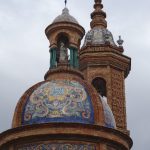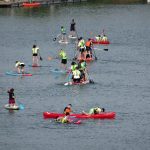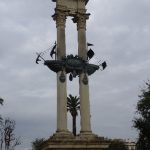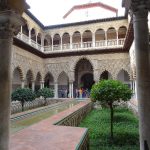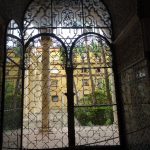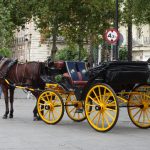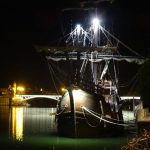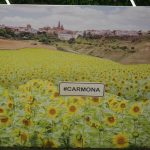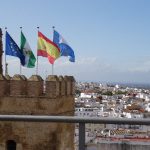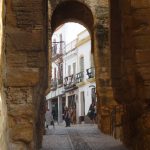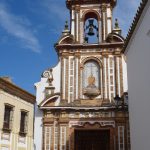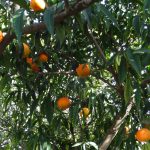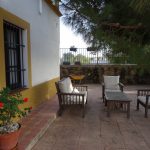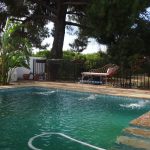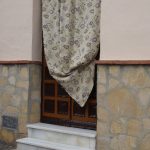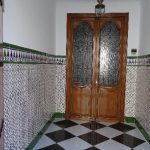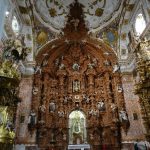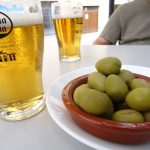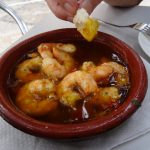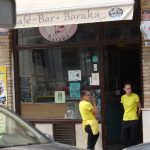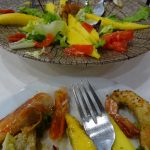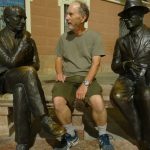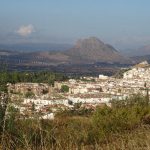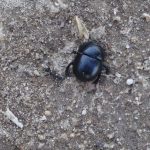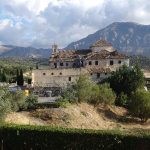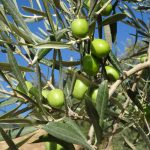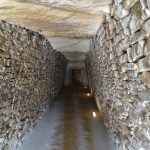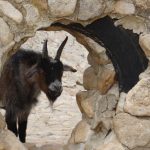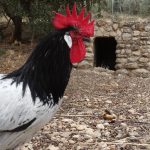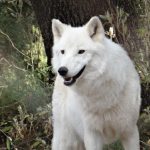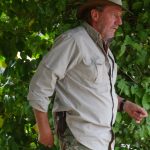-
The Rock of Gibraltar
The morning dawned — foggy, cool and a touch of drizzle. No … not what we need! The clouds were so low they almost touched the sea. Should we put off until tomorrow? The BBC weather forecast claimed that Tarifa was 17C and foggy whereas Gibraltar was a sunny 24 … such a difference in a relatively short distance. We decided to chance it.
Approaching Algeciras … there across the bay was Gibraltar, clear and bright. Yess! Parking in La Linea de la Conception was quite simple … perhaps not the parking lot Glen had found for 3 euros a day — but it was close to the border. Customs was a breeze … and then, we were walking across the air strip … people all around taking photos (despite notices saying “no stopping on the runway” .. who could blame them.
The first thing you saw was a red British telephone box … then The Casemates square — which is filled with restaurants now. Main Street was a sea of humanity all looking for a duty free deal, or beer, fish and chips, or a curry. We struggled against the surge and found John Mackintosh square – location of our first apartment in Gibraltar. Of course the building has been totally revamped, but the square still looks much the same. Then there’s that distinctive accent … British overtones, but with a drawled Spanish twang. We had bus passes, but there was a major accident somewhere along the line, and the one-way flow of traffic had ground to a standstill . . . British Bobbies directing traffic.
We walked up one particularly congested street crammed with buses cars and taxis, but scooters were determined to squeeze through regardless of pedestrians or vehicle paint.
The cable car up The Rock was busy. Two options … ride up, look at the view, see some of the Barbery apes and ride back down – 18 Euros. OR ride to the top and walk down through the Nature Reserve (pretty much ALL of the upper Rock), St, Michael’s Cave, the World War II and Siege Tunnels, etc. — 34 Euros each. Now, you could walk up to the halfway point — it would be a good workout but you still wouldn’t be able to reach the very top.
There were high clouds, but the view was crisp and clear in every direction … the whole of Gibraltar spread out below. The west side with the old town within the walls, docks, marinas and a lot of new apartments and hotels on reclaimed land … the airstrip, and over to La Linea and Algeciras across the bay. The east side of Gib — the shady side — with Sandy Bay and more new highrise buildings being constructed near the air strip. Way off into the distance were Estapona and Marbella along the Costa del Sol.
And then there were apes (actually Barbary Macaques) … with attitude …
everywhere. Posing on walls … grooming each other …. ambling past, checking out the visitors. Posters and warnings everywhere — Do not carry food or plastic bags which they associate with food … Do not Feed, Touch, Glare at, Make Faces at the apes … they can and will bite. Even then, one would suddenly leap on some poor unfortunate person, giving them a scare before letting go. We rescued one such German lady, visiting on her own . . . and shortly afterwards another ambushed Glen (ape that is, not eine Frau). Mums with tiny babies clinging … large males lounging indolently on a cement barricade, yawning and showing off their impressive inscisors.
The saying goes, that should the apes ever leave Gibraltar, The Rock would fall … so back during WWII, Winston Churchill had reinforcements brought in from the Barbary Coast in North Africa to ensure against this. For years they were members of the British Army … had military numbers … and even an army soldier appointed to look after them. Today, they are cared for by the Gibraltar Nature Reserve. This link gives you an interesting background and great photos of the Barbary Macaques. https://gibraltar.com/en/travel/see-and-do/upper-rock-nature-reserve/gibraltar-monkeys.php
Other attractions are the glassed floor viewing area giving hair-raising views over the eastern side, the Windsor Suspension Bridge providing western visas … St. Michael’s Cave – a beautiful Cathedral cavern with amazing limestone structures, however we thought the coloured light show and loud music an unnecessary distraction.
A welcome ice cream to sit and rest weary feet while soaking in the views and watch cheeky ‘monkeys’ balance on top of the constant stream of taxi vans. Leaving Glen at the table, I wandered off to find the bathrooms, fortunately
having packed away the camera and my glasses first. Just as well . . . as one of the Macaques swept in and made a grab for whatever was on the table. Glen hadn’t seen me secure the camera and feared the worst … but the only ‘prize’ was an empty ice cream pot, which was carried off, thoroughly licked out and torn to bits.
Working our way across The Rock, we had left the Great Siege Tunnel till last, only to find it had closed early! At least we had a great vantage point for the plane just taking off. Stood chatting with Brigitte – the German lady from earlier – she mostly in German, us mostly in English. Somewhat older than us, she was happily driving herself about, seeing
the sights — having left her husband behind in Dresden – I gather he had no interest in traveling. Hope we have her adventuresome spirit in a few years.
A delicious curry and an excellent masala tea … a bus to the border (again a breeze) … the car still where we left it (you don’t want to know the cost after over 9 hours) … and back to Tarifa. The road up to the house is quite the experience in the dark!
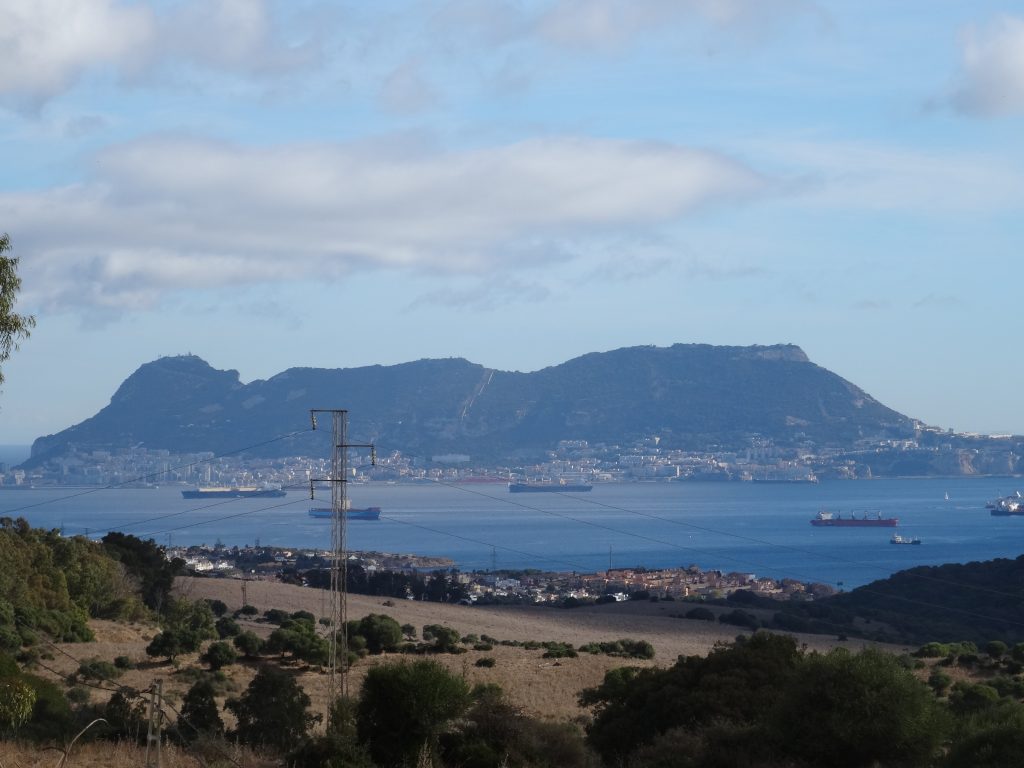
Gibraltar from Algecires 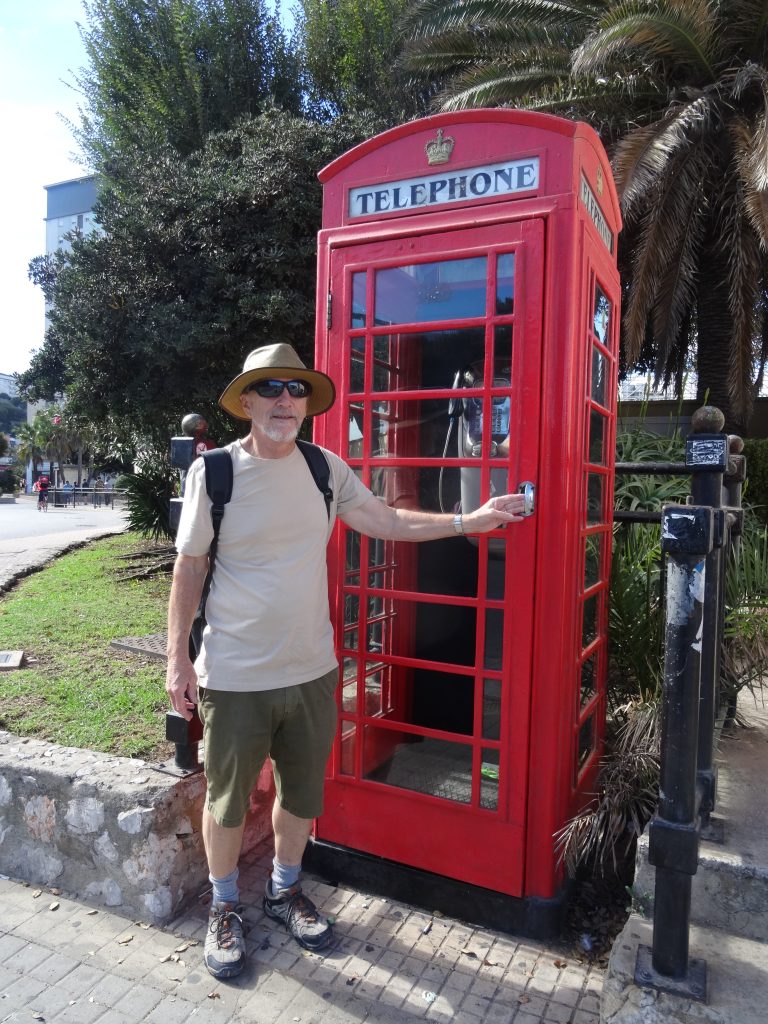
Of course there’s a British Phone Box 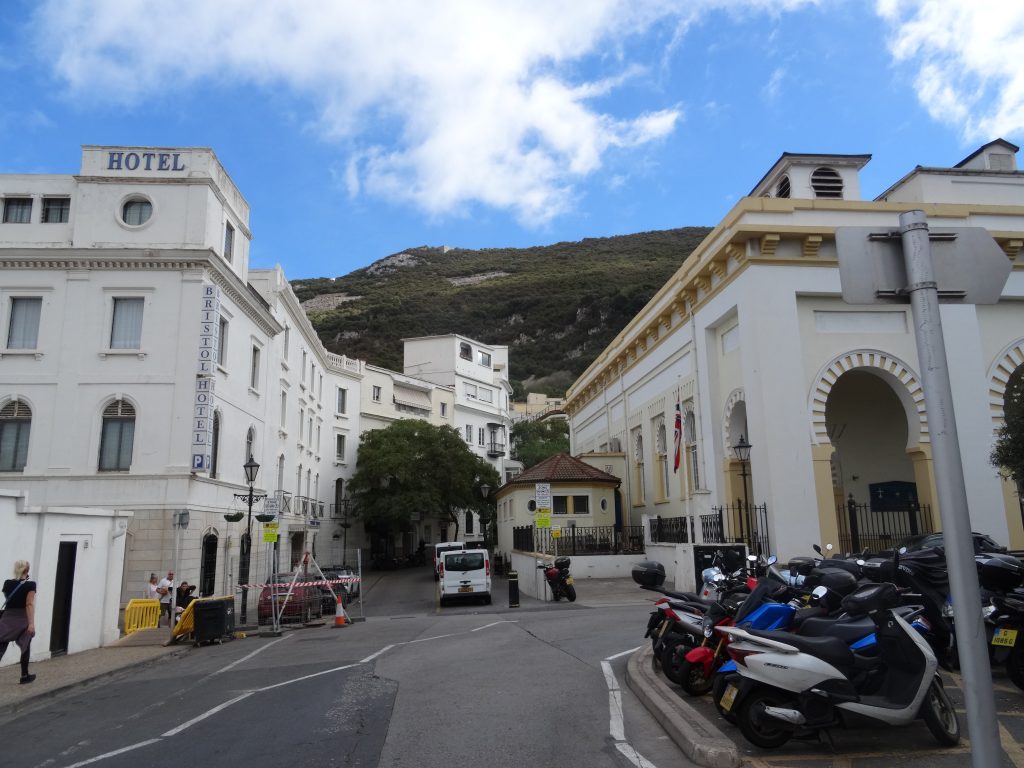
Part of the old town 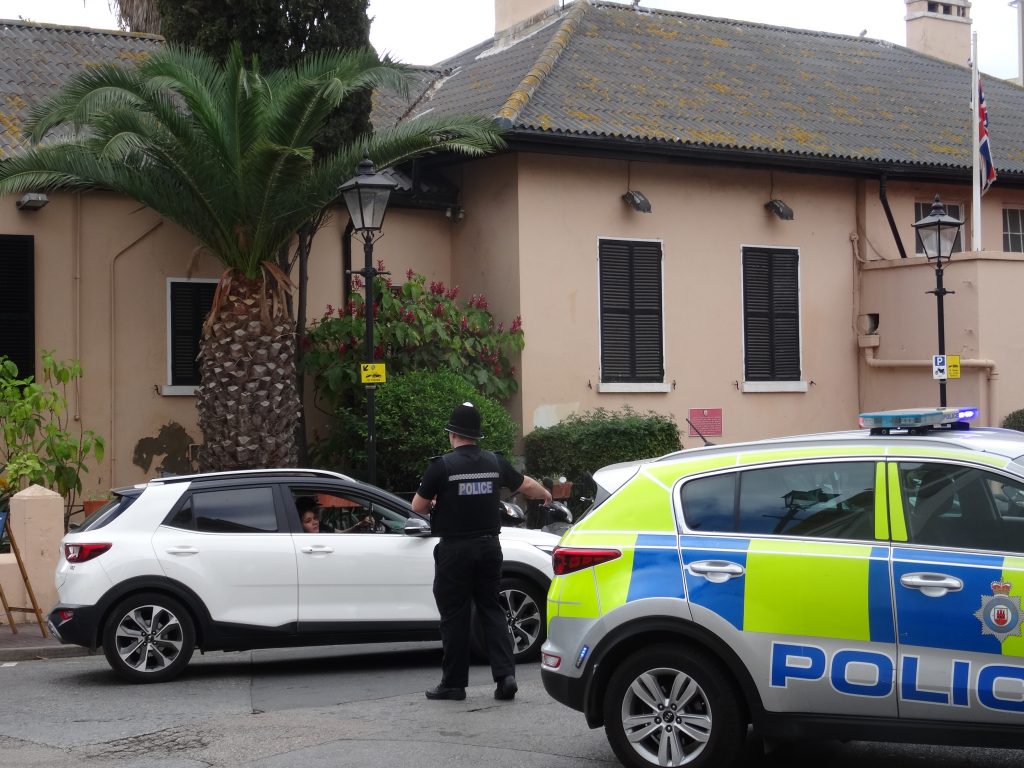
British bobby directing traffic 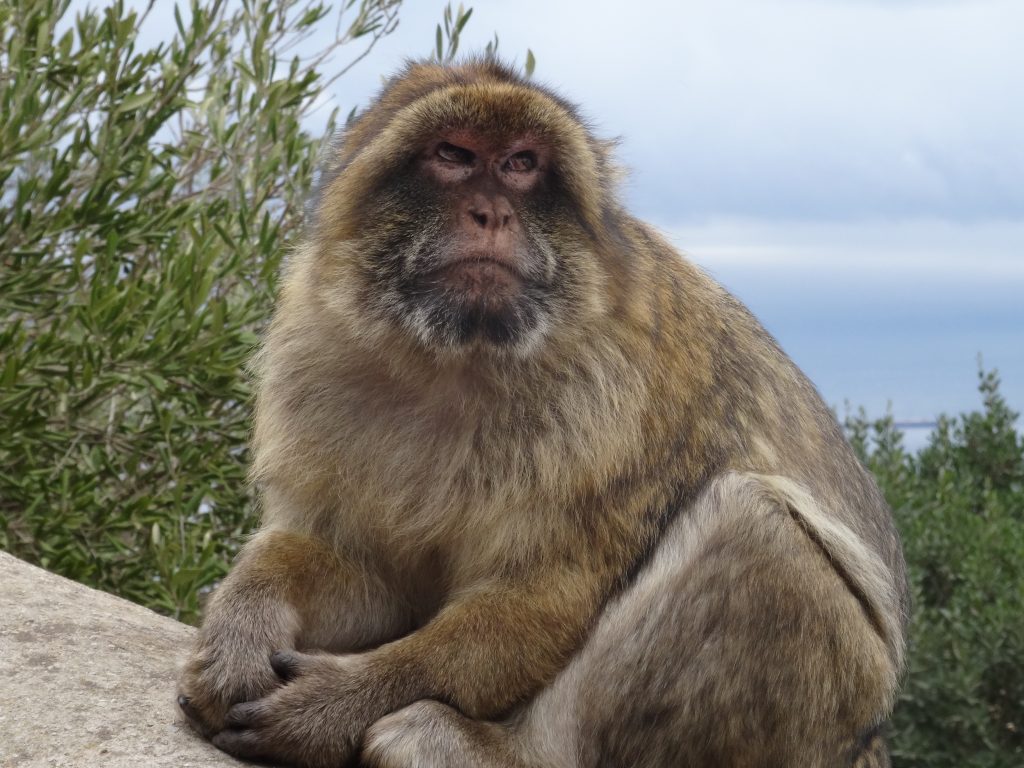
Gibraltar Macaque 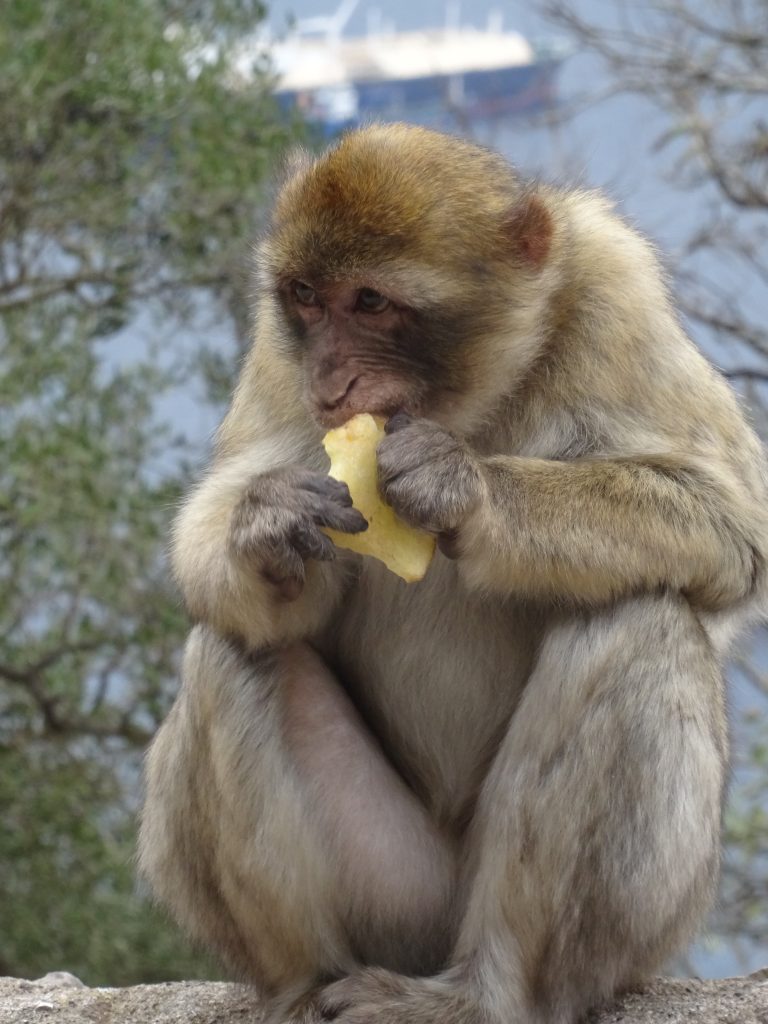
Don’t be fooled – they’re not as innocent as they look 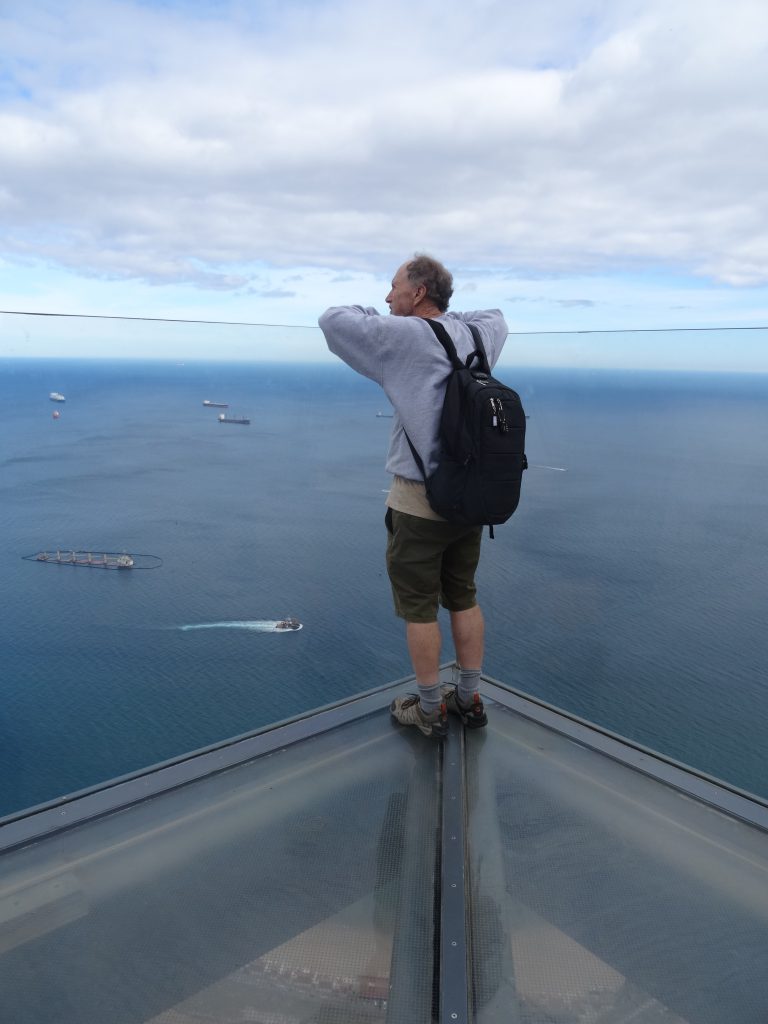
Glass viewing area 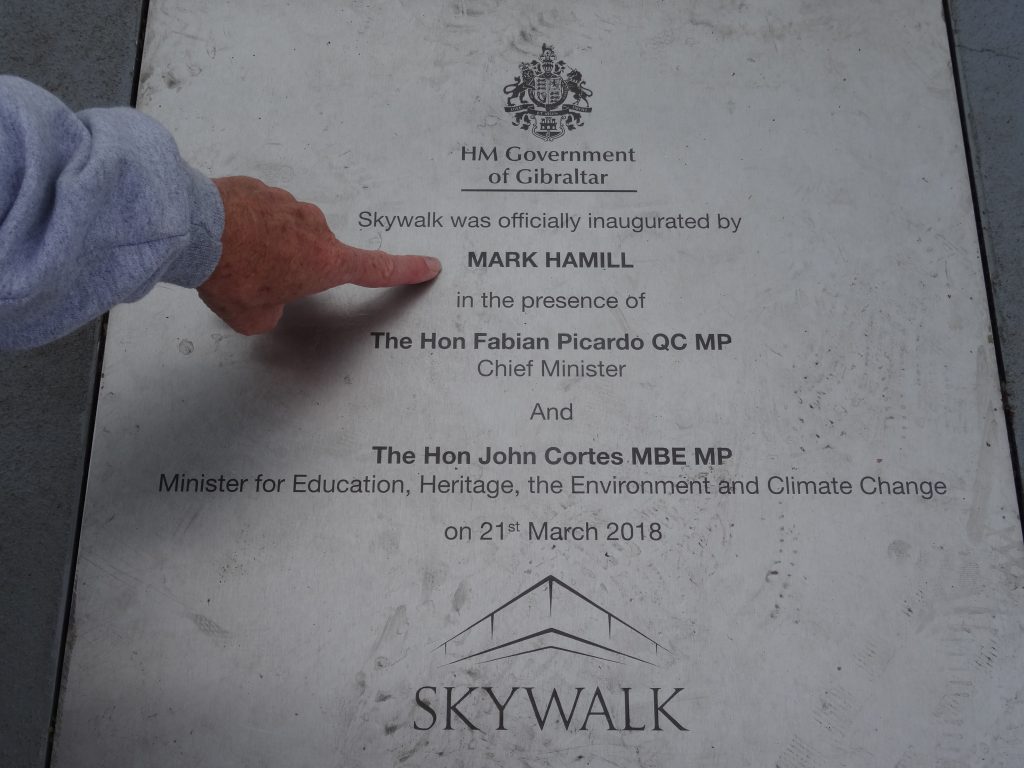
Opened by Mark Hamill 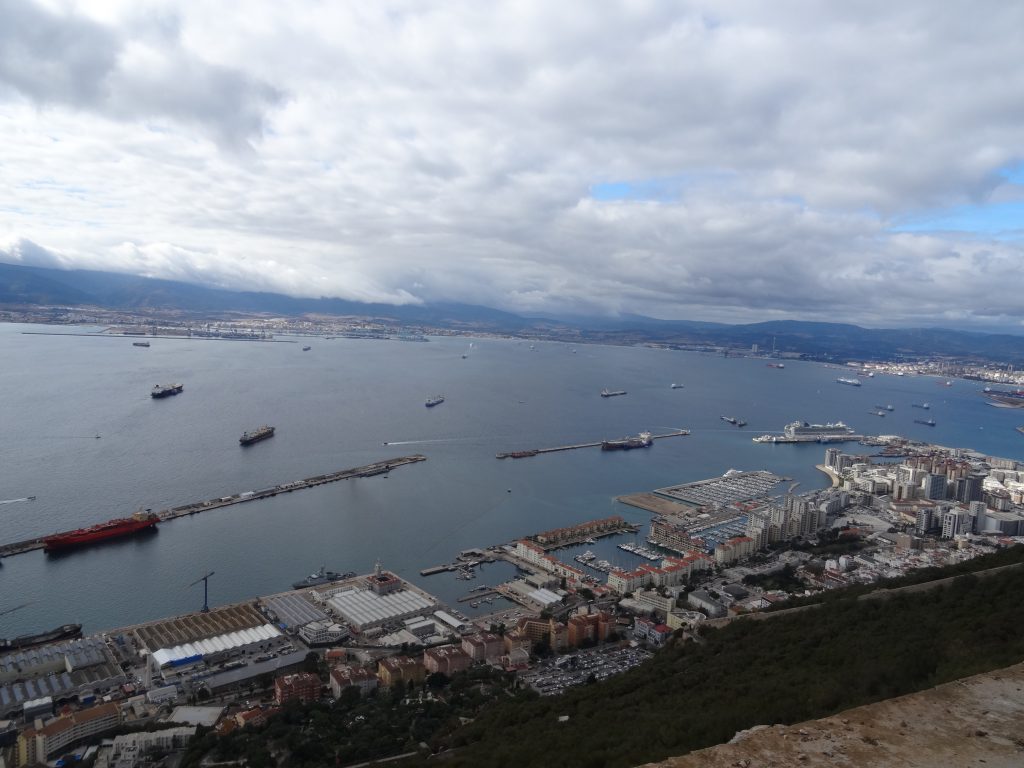
West side of the Rock 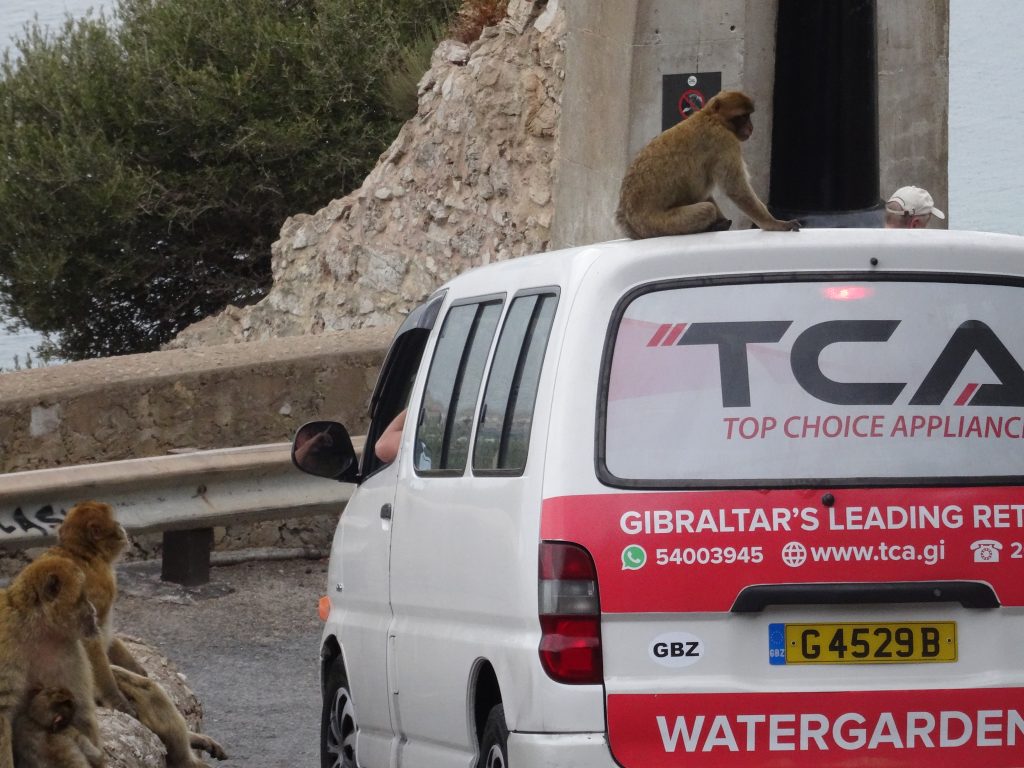
Taxi Ride 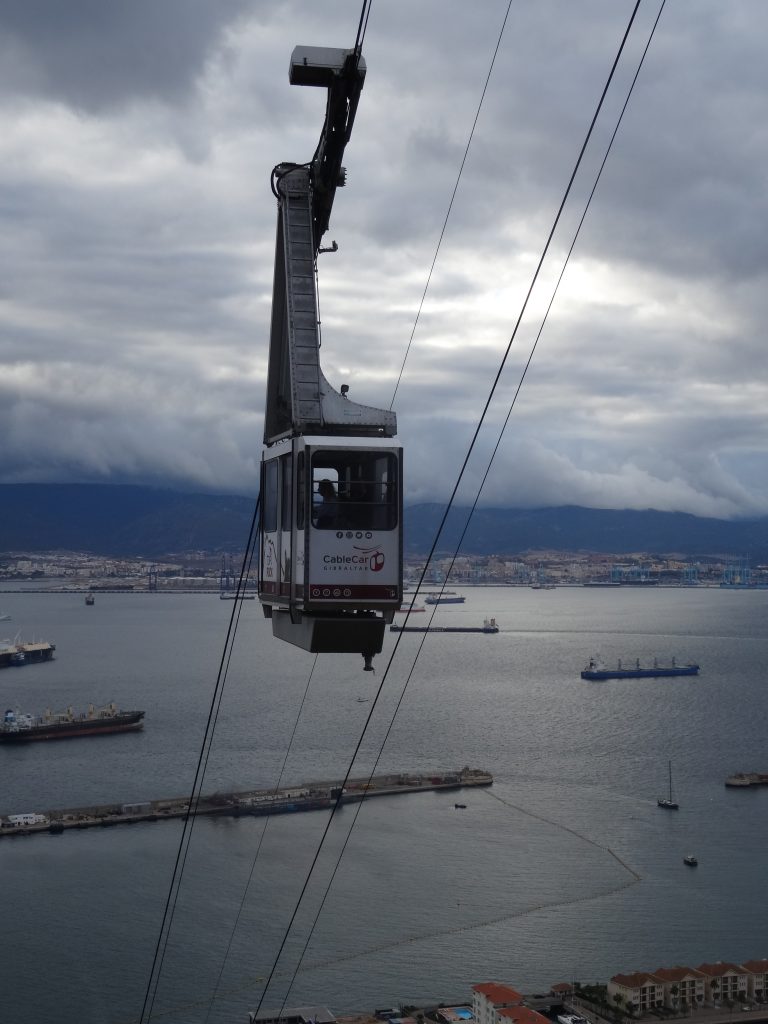
Air Tram to the top 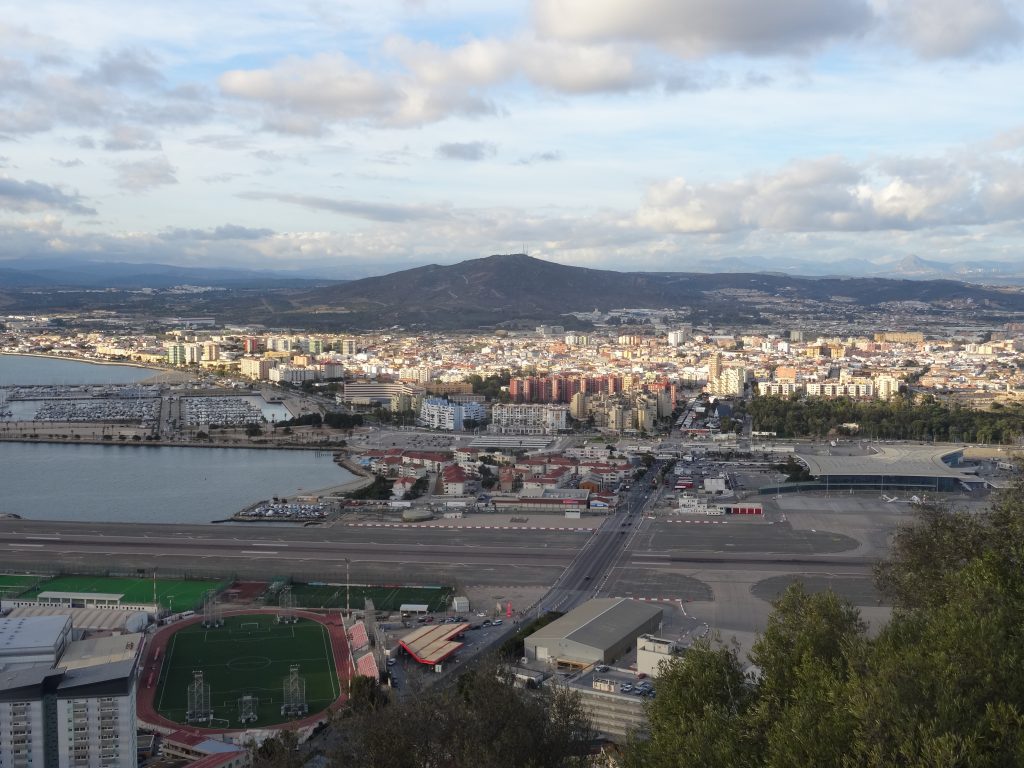
Runway with La Linea in the background -
Tarifa – and all parts South
Certainly a village not to miss is Vejer de la Frontera. Now, you ‘re probably thinking that we’ve seen FAR too many white pueblos already this trip, but honestly, this is a beauty. Mid week, it was quiet … the sky was that impossible deep blue that only the Mediterranean can achieve … every doorway enticed you into hidden patios with luxuriant potted plants and trickling water — each better than the one before (they are probably very competitive!). Tiny shops with displays of goods on the walls outside — wonderfully smelling leather goods … or intricately woven straw products. That aroma immediately transported me back to childhood, with straw shopping bags or sombreros. There was an old windmill on the hill . . . and the brightly coloured tiled fountain in the central plaza had frogs spouting arcs of water into the air. The kids loved it.
The scenery between Vejer and Tarifa was rolling grasslands … Cattle country. Fields were a desiccated brown after the summer but the hills were covered with a green woolly fleece of cork oaks. Harvesting of cork is now highly regulated, and can only be done for a couple of months
each year — usually around June and July. A highly skilled process of cutting through the outer bark without damaging the under layer – the sheets of cork are pulled off and stacked for up to 6 months to mature. You could drive past these piles of apparently scrap wood and not realize this is a highly valuable commodity … https://www.andalucia.com/environment/cork.htm
As our next apartment near Tarifa was somewhat rural, the owner (Gisella) offered to meet us at a restaurant on the main road and guide us in. And what a place — Right on the edge of a nature reserve! An unmarked road, which technically was ‘paved’ but was so ancient and uneven the car rocked wildly from side to side – over tree roots and around rock walls. In through some high wrought iron gates, the garden path wound its way through a veritable jungle of lush vegetation, palms and enormous cactus to a spotless villa . . . with a spacious flag-stoned patio overlooking
the Straits to the mountains of North Africa! Originally from Germany, Gisella and her husband had lived in Tarifa the past 4 years, so we toured the house and property in a peculiar mix of German, Spanish and English … but it worked.
Tarifa is the windsurfing/kite-flying capital of Spain . . . the winds off the Atlantic make it the perfect location. Every second store along the main street either sells, repairs or teaches these activities, and it seems the rest are yoga places … offering yoga on the beach … or even mountain yoga retreats. But there’s a lot more to Tarifa … the old fortress walls
and arched gateways into the city … the ubiquitous narrow cobbled lanes – now strung with Christmas lights. And we were treated to the most glorious, firey sunset that went on and on and on — for the best part of an hour … deepening, changing … far out across the Atlantic, with trees and mountains as black silhouettes.
Making sandwiches the following day, I could hear a cacophony of sound that appeared to be getting closer …
somewhere between steel drums being played badly and an array of pots and pans clanking together. Goats … and a lot of them! I rushed out, camera in hand, and sure enough along the lane in front – a flood of goats. Filing in single line at first, then a veritable sea of brown and white .. all with clonking bells round their necks, or smaller ones jingling from their horns. Bringing up the rear a dog — and the goatherd riding a
mule — eating his lunch! He waved his sandwich in greeting .. and carried on down the lane. No wonder we had been warned to keep the gates closed. There’d have been nothing left of the lush garden if that lot had got in!
Then, as we drove out and bumped and rocked down the road … Cows …
laying in front of our neighbours house … chewing the cud and enjoying the sunshine.
There’s a whole Roman city just down the road in among the sand dunes … and this time we weren’t disappointed. It was easy to see the excavations of marketplace, villas, bath houses, with their under floor heating, fish-salting tanks, amphitheater … and of course columns and statues. I wonder if they had gift shops in those days? … get your crypt magnets – only 5 denarii!
Not a bad video of the area leading to Tarifa and the Roman ruins … You can skip over the museum bit and rejoin the video around the 6 minute mark. https://www.youtube.com/watch?v=FUWXkfDEMO4
It’s positively therapeutic to sit on the patio, listening to the birds and the never-ending stream of ships glide by. Tankers, freighters, tugs, cruise ships, container ships the size of small islands. Mostly east to west – from Suez through the Straits of Gibraltar. A naval ship was obviously on patrol between us and the Moroccan coast – cruising back and forth. Looking for smugglers? pirates? migrants?
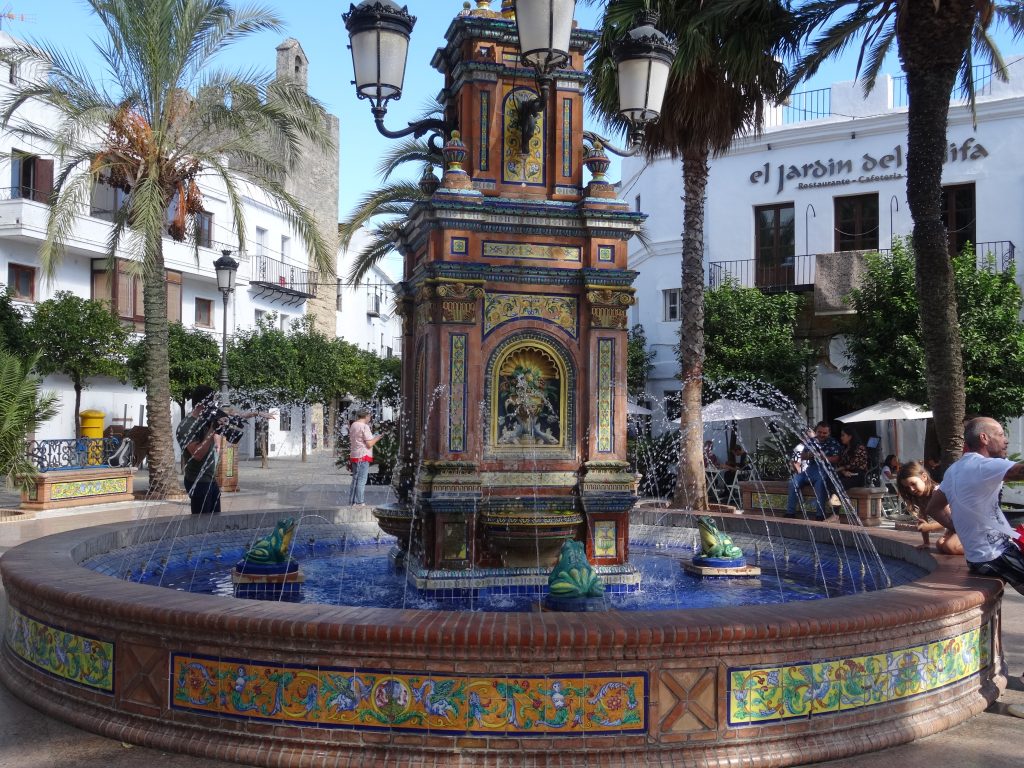
Frog Fountain, Vejer 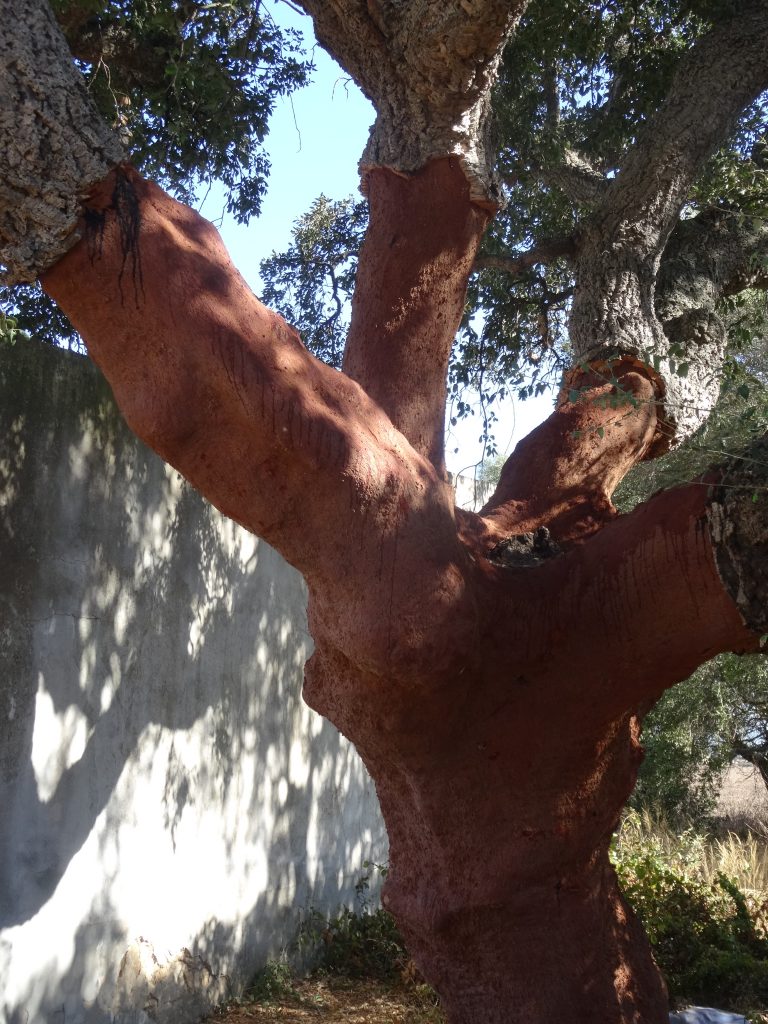
Harvested Cork Oat 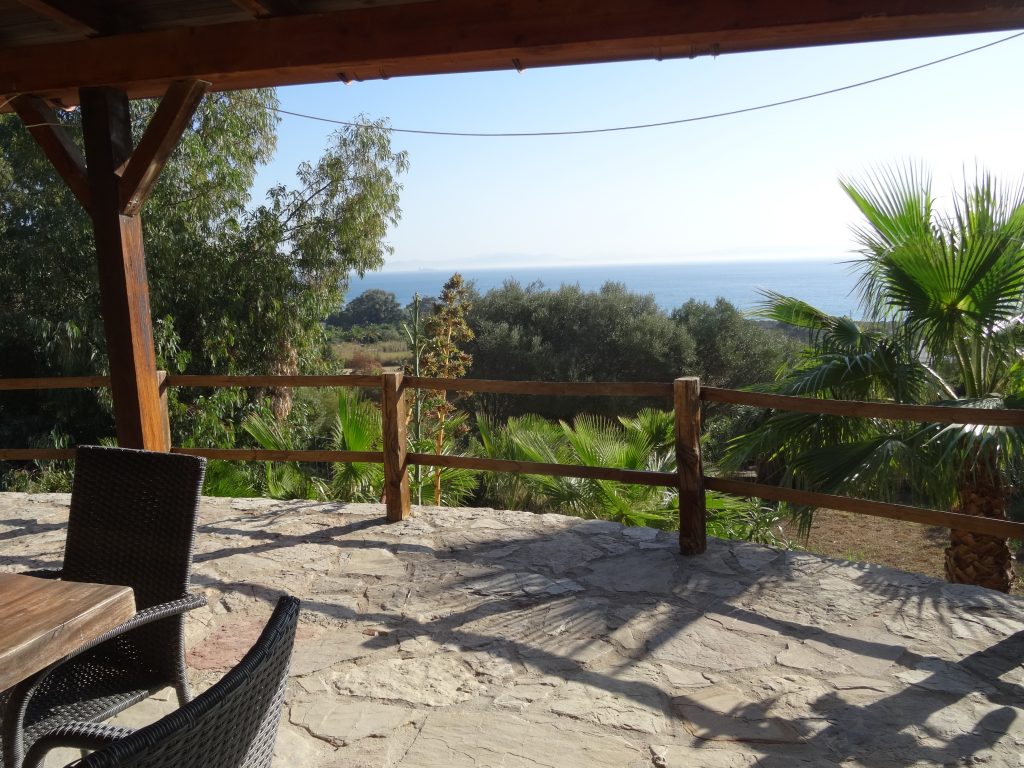
Our Patio overlooking North Africa 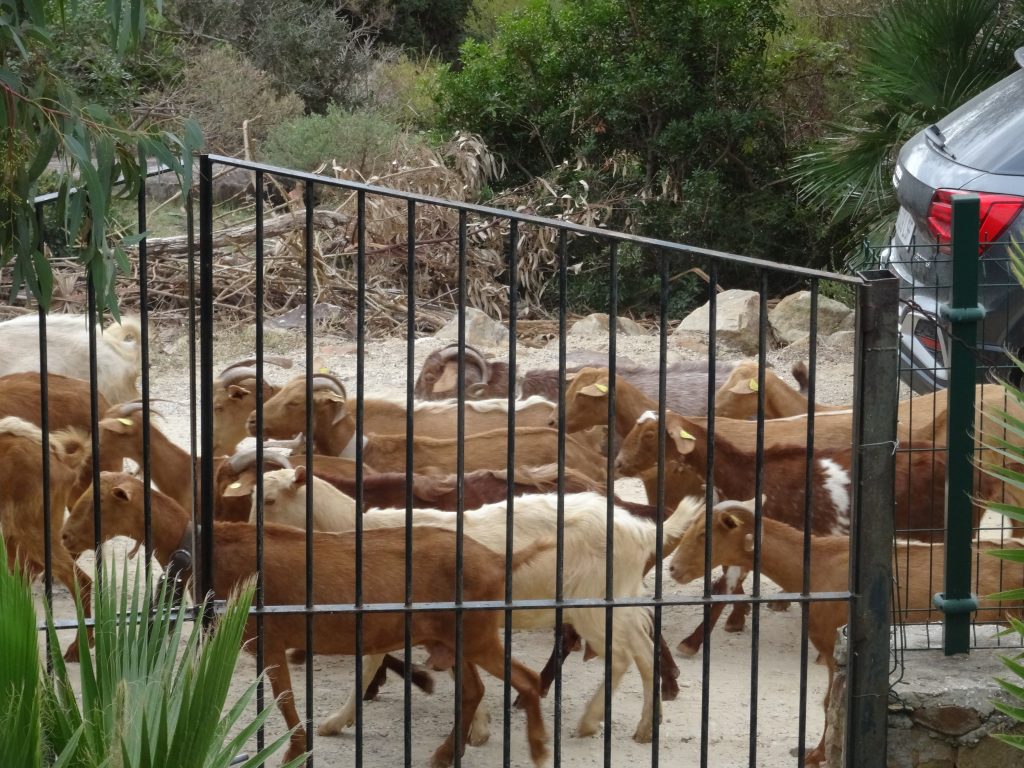
Deluge of Goats 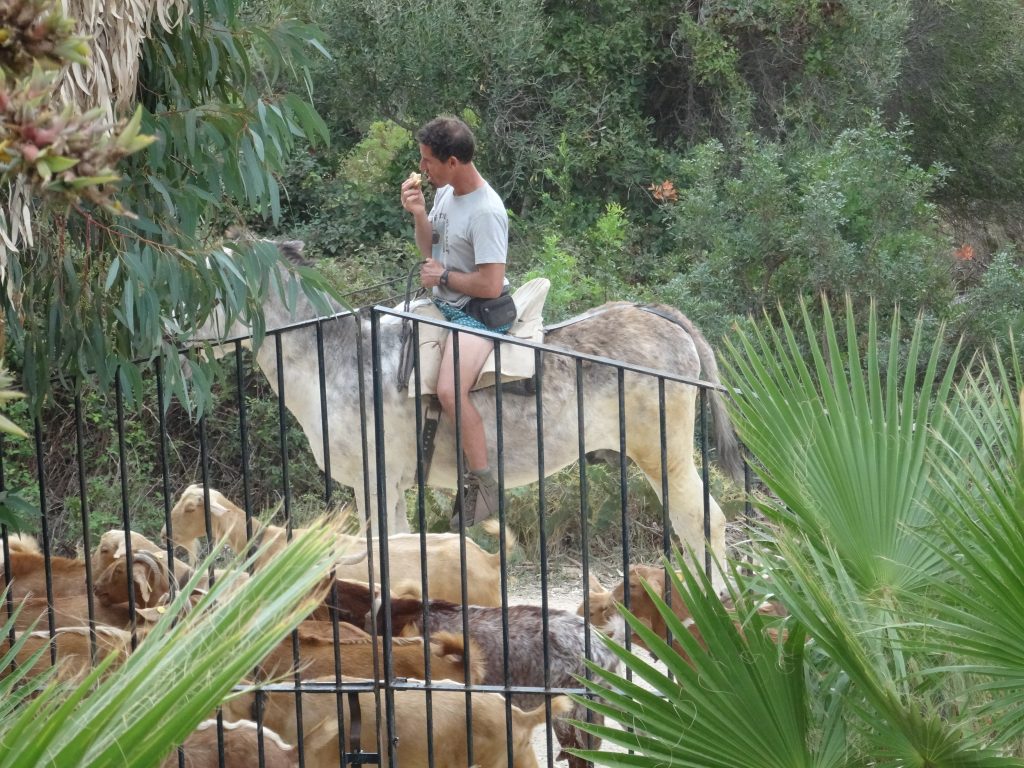
Followed by the Goatherd 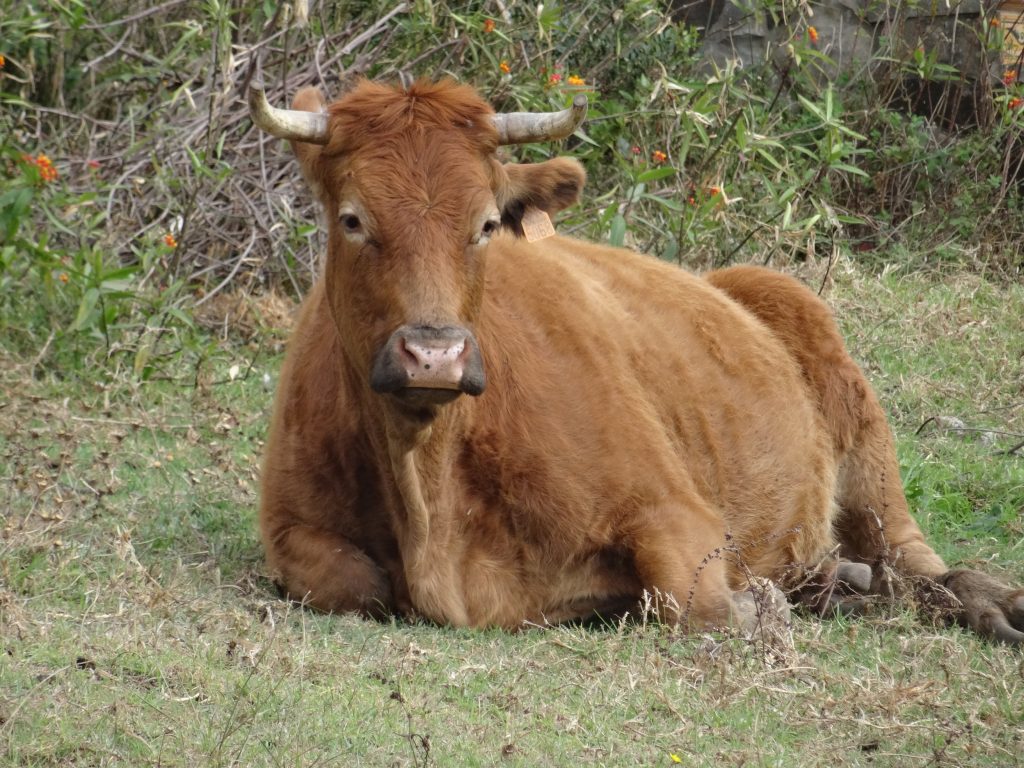
Neighbourhood cow 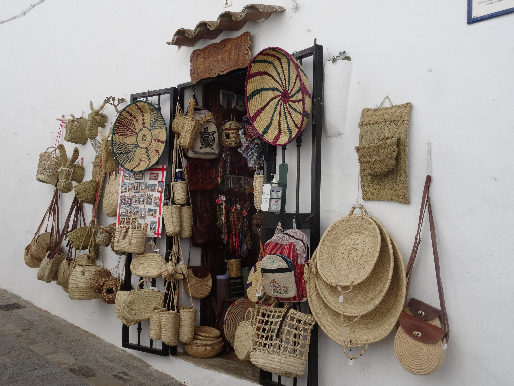
Straw Hats, Vejer 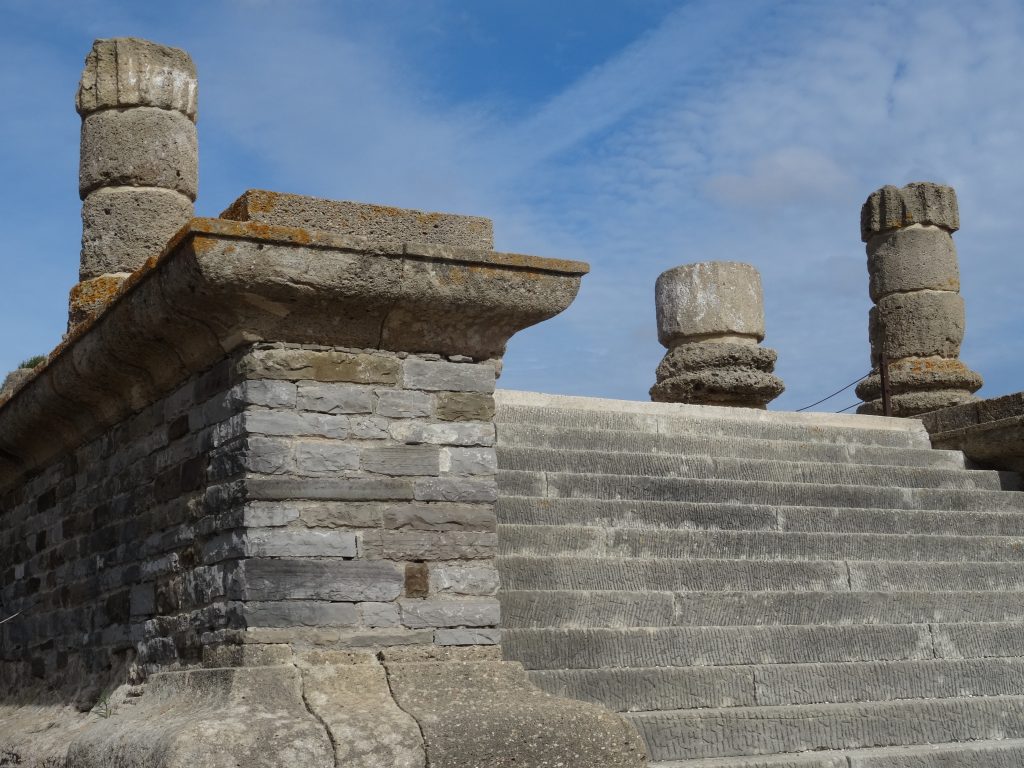
Roman Ruins, Tarifa 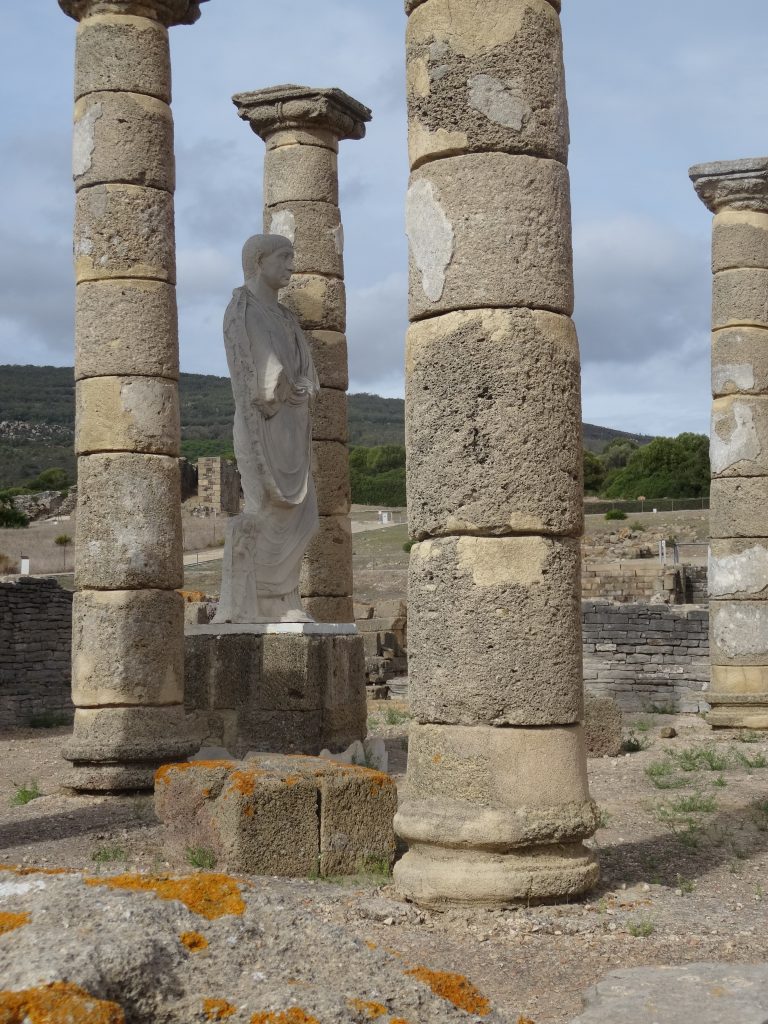
More Roman Ruins 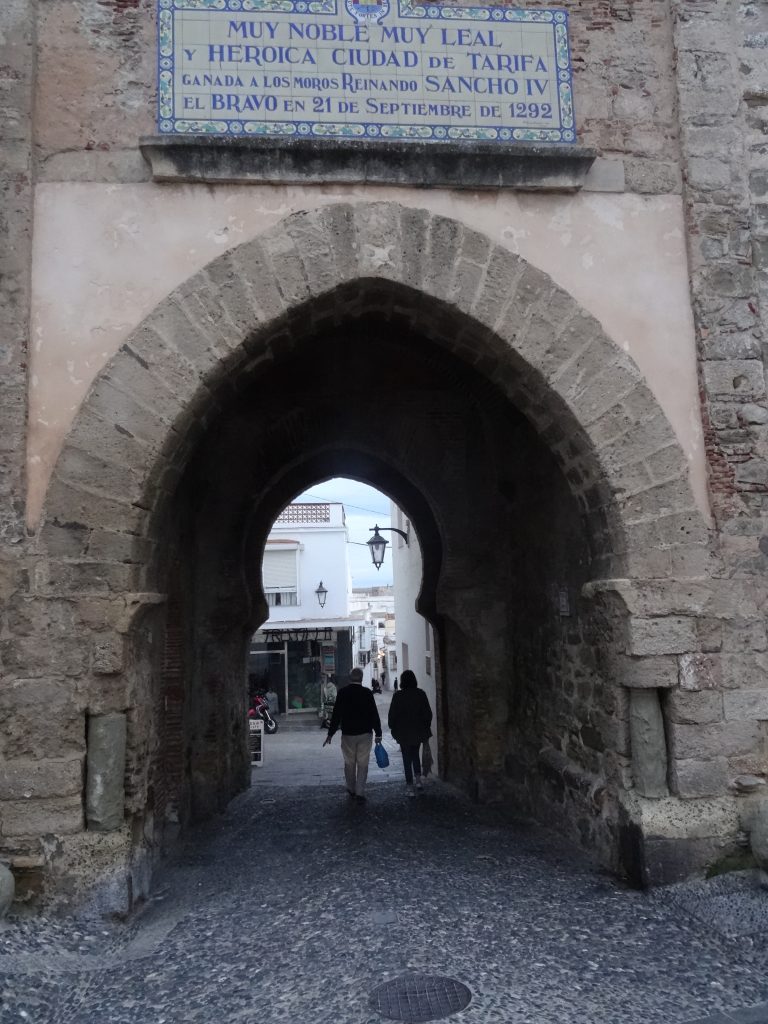
Old walled gate into Tarifa 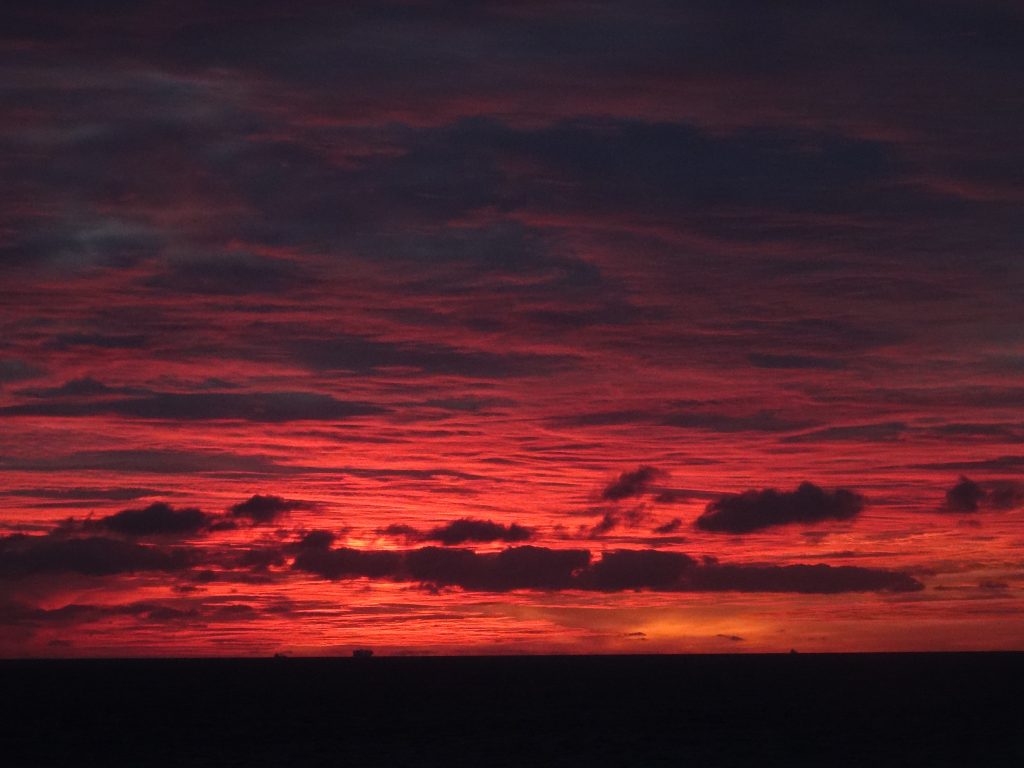
Glorious Sunset -
Cadiz, Dancing Horses & Halloween
Along the road to Cadiz — two interesting sights. The first being huge, untidy piles of twigs on the roof the of an
abandoned building. These of course were stork nests. There were several of them standing or sitting on them … peering down at us. Some parts of the world consider it lucky to have a stork nest on the roof, and will install an old wagon wheel or other structure to encourage them to build.
The other, were the salt flats at Salinas de Chiclana … shallow flat ‘pans’ where seawater is let in and evaporated in the sun. When the crystals form a crust on the surface they’re raked into great white mounds, cleaned and sold. There were flocks of flamingos striding happily through the saline water when we drove by.
Cadiz has become a GINORMOUS seaport. Huge cranes towering over the loading terminals, and quite the biggest, highest suspension bridge we’ve ever seen, spanning the bay into the old city. An underground parking lot near the cruise ship terminal had spots available and was fairly central to much of the old town. . . . but boy, were the parking slots tight. I hopped out, and Glen backed in … it’s like sardines in a tin. The iconic buildings along the waterfront look the same — pastel shades of pink and faded blue in amongst the sandstone … the domes of the cathedral … a wide boulevard lined with palm trees … marble steps down to the
sandy beach. The atmosphere felt quite different from other places we’ve visited … more exotic, somehow.
Lunch in a tree-filled plaza. Time to try a paella, perhaps? I know it’s not Valencia (original home of the dish) but surely other places do a good job. The seafood was fresh, but there was a decided lack of it …. I wouldn’t call two large prawns, a couple of rings of octopus and a scattering of unidentified bits in an almost soupy tomato rice base, a seafood paella. Oh well … visitor beware! We’ll find a good one yet.
The Royal Andalucian Equestrian School of Art is based here in Jerez. It not only preserves the ancient line of Andalucian horses but is a world class riding school with performances at dressage competitions … and of course there are the ‘Dancing Horses’. These are not the Lipizzaner horses (although
Lipizzaners were originally bred from Andalucian mares sent to Austria) — they range in colour from light grey or white to chestnut. Many of the moves and choreography in the show are derived from their original use of rounding up cattle — cowboys needed one hand free for the long poles used in moving the animals. These were the original cowboys – the ones in America and on the South American Pampas merely adopted the techniques because they worked so well.
The behind-the-scenes tour was really informative, but this is a working stable and visiting tours have to step out of the way pretty sharply if the horses are being moved in and out. The show itself was a delight –
intelligent, graceful horses … the muffled thud of hooves on raked sand … the rapport between rider and horse … absolute precision and coordination. The years and years of training shines through. It’s too bad that the couple next to us couldn’t appreciate all that. They spent the entire show using cell phones … videotaping and endless photos which they uploaded in real time to goodness knows who. Neither actually ‘watched’ the performance. Sad. They could have saved themselves the cost of admission, and just downloaded from the internet! This is a nicely done 6 minute video: https://www.youtube.com/watch?v=6bLY32mi018
We’d heard that Spain was just beginning to celebrate Halloween, but hadn’t thought too much about it. After dinner on the 31st Glen said “you know … there seems to be some activity over towards the square” … so we went to find out. The whole main street and plaza were filled with people … tiny tots … teenagers … Mums and Dads … all in costume and face paint. Old folks on benches or chairs pilfered from sidewalk cafes, watching the crowds of families parade up and down the street. We asked a couple if we could take their photo . . . as you can see we were immediately embraced into the picture! This celebration was not going to end anytime soon! Thinking we could slip down a side street back to the apartment — suddenly motorcycle cops appeared with blue lights flashing … people started lining the streets … little kids sat cross-legged on the ground in anticipation … there’s going to be a parade! We stepped up into a convenient doorway – a good vantage point, and out of the way.
You could hear and feel the music long before anything appeared … it pounded up through the soles right into your chest. Then 15- foot lit skeletons wandered by … flashing heads … hands reaching for squealing kids. There were people riding dragons . . . a truly massive ogre-type monster hauling a cage on wheels . . . dancing kids performing intricate routines they’d obviously been practicing for weeks. So … do they celebrate Halloween here? Oh Yes! They’ve embraced and run with it. Any time there’s something to celebrate … Spaniards will turn it into a 3-day Fiesta … and this one was not about candy or sweets, it was a family affair. We loved it … even if we lost a few hearing cells! Three days, you ask? … Oct. 31st – El Dia de las Brujas (day of the witches) … Nov. 1 – All Saints Day (National holiday) … and Nov. 2 – El Dia de los Muertos (Day of the Dead).
Before we knew it, our time in Jerez had melted away. With both a Sunday AND a National holiday, we didn’t manage a visit to one of the Bodegas … but you could certainly smell the sherry as you walked past the substantial properties … drifting over the walls of the likes of Harveys, Sandemans, Gonzalez-Byass (Tio Pepe) and Fundador https://everydayfoodblog.com/spain/sherry-bodegas-jerez/
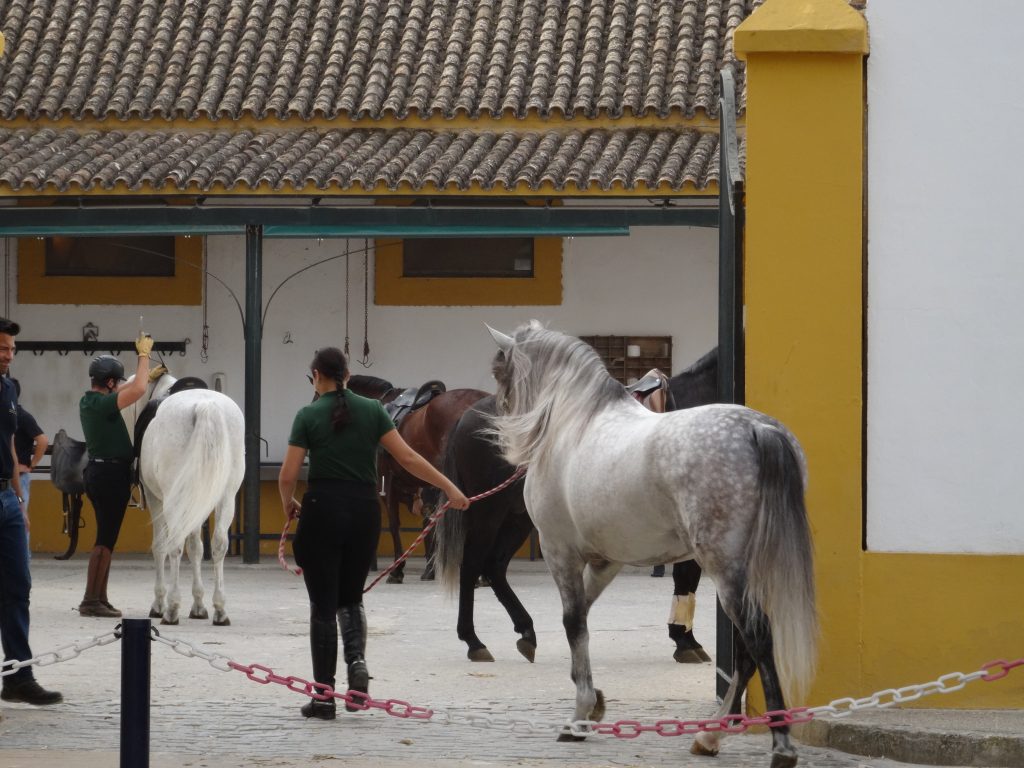
Working Stables 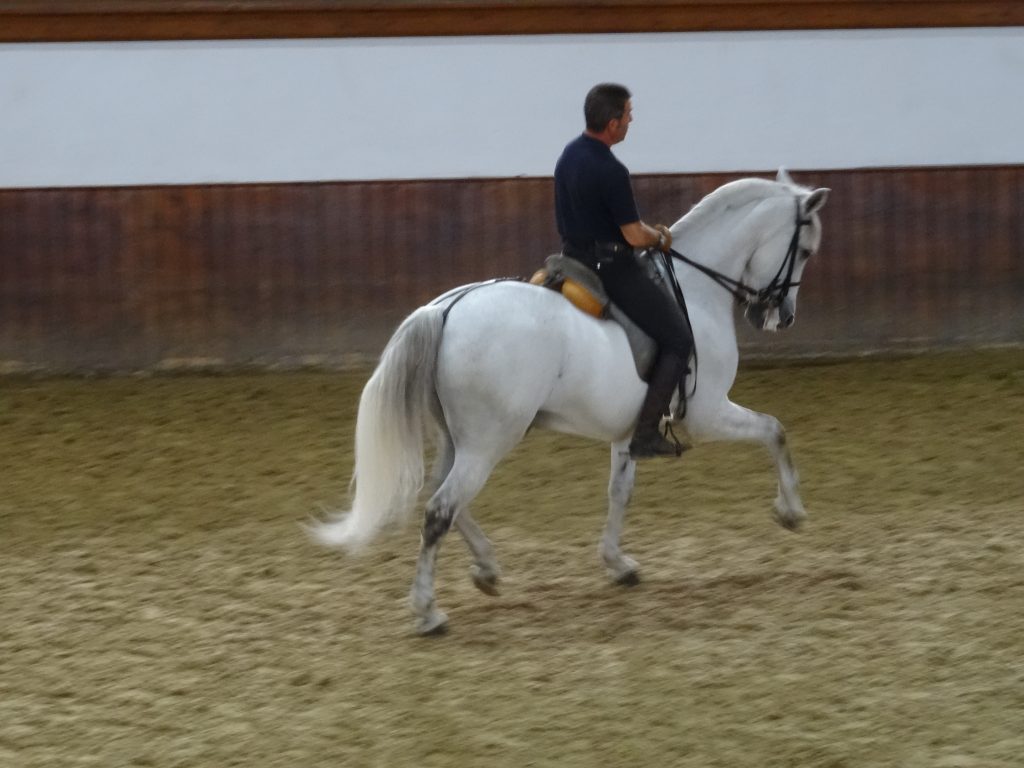
Practice 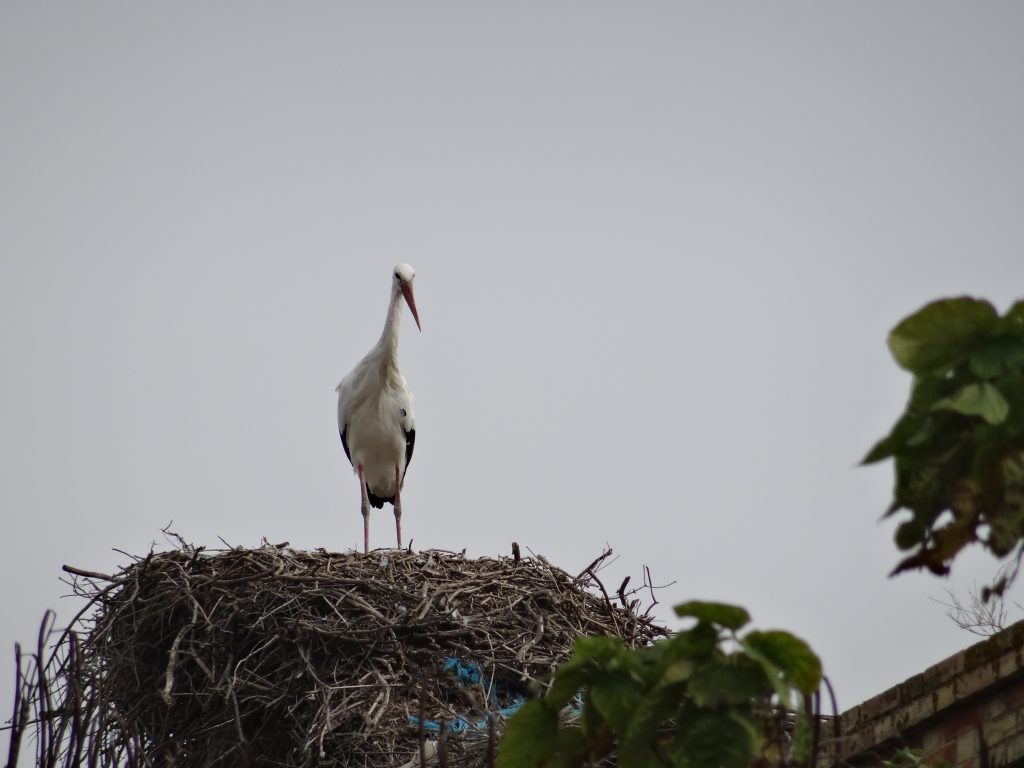
Stork Nest 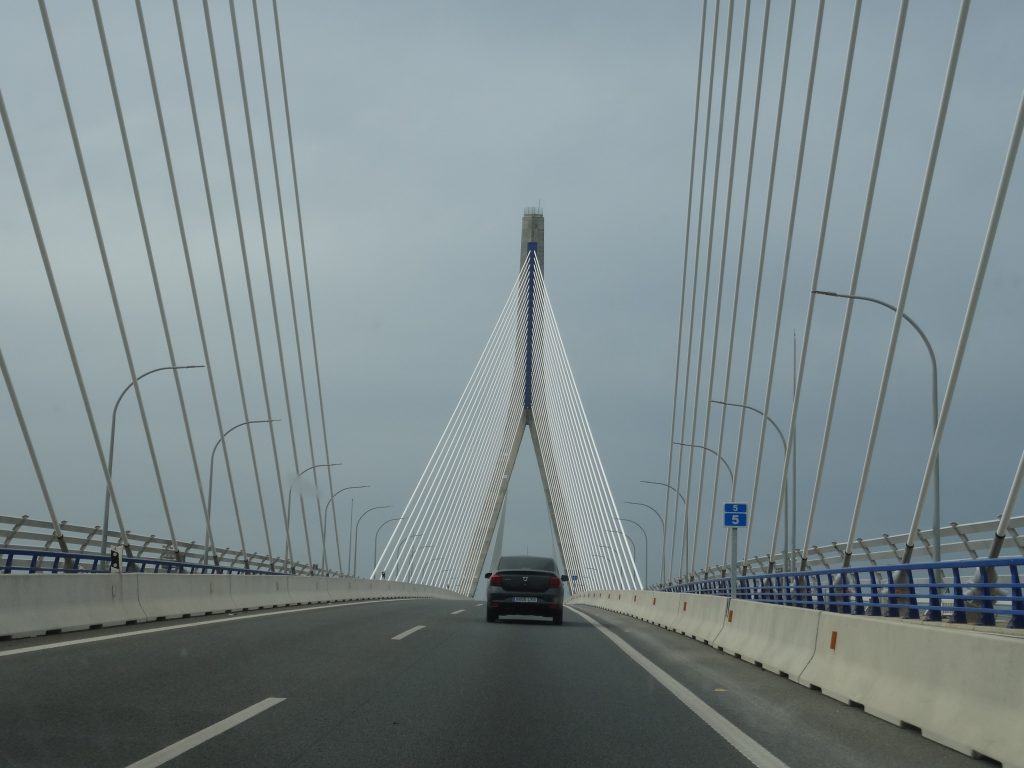
Massive Suspension bridge to Cadiz 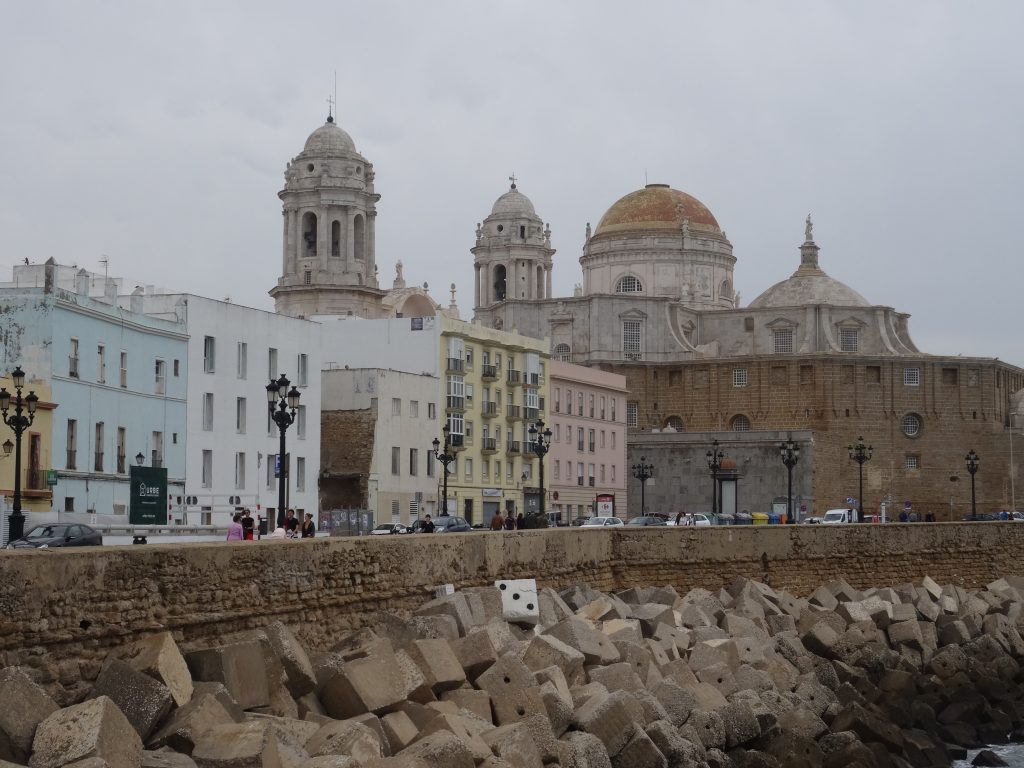
Iconic Cadiz Waterfront 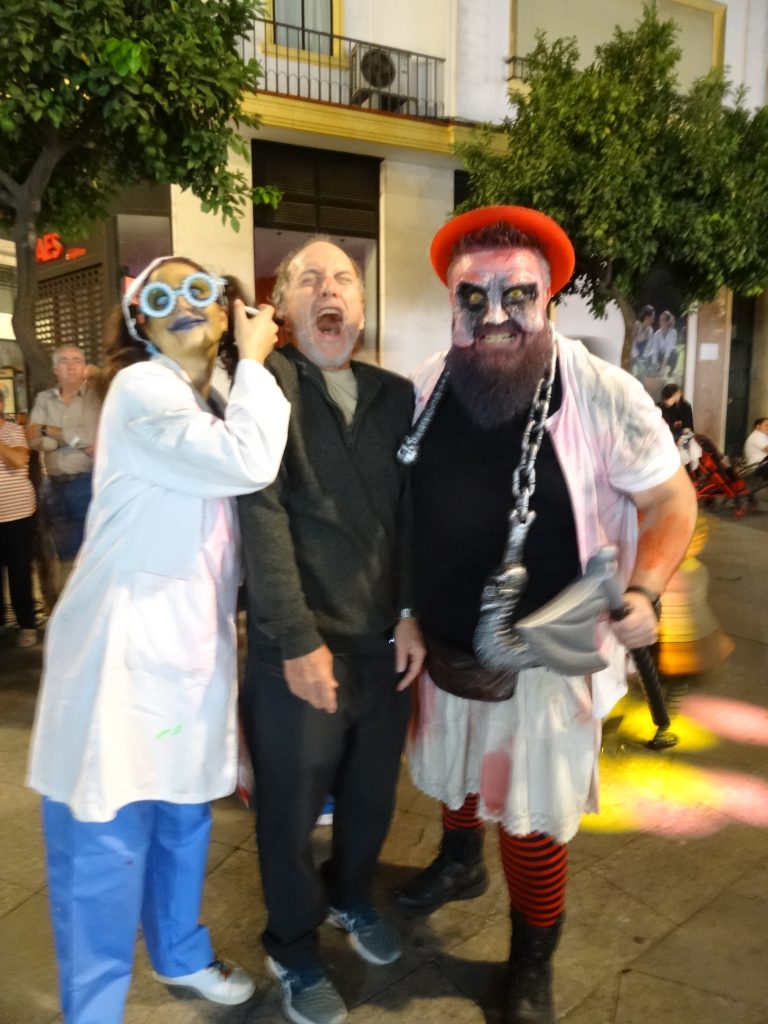
Joining in Halloween 
They were fun 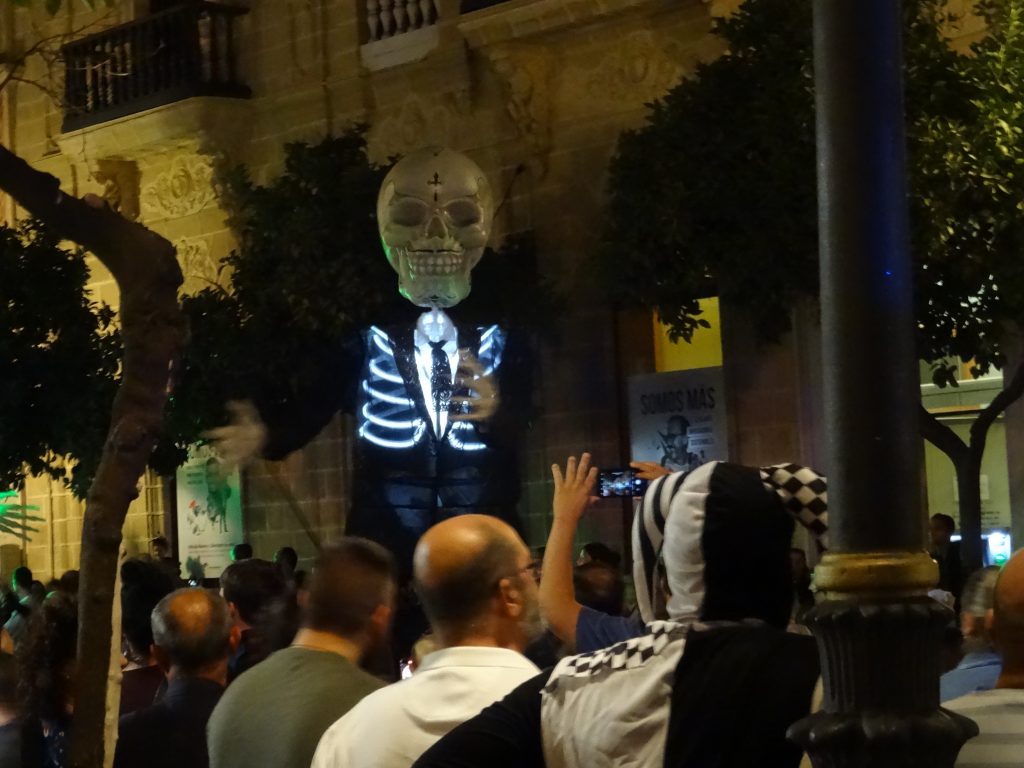
Scary Skeleton 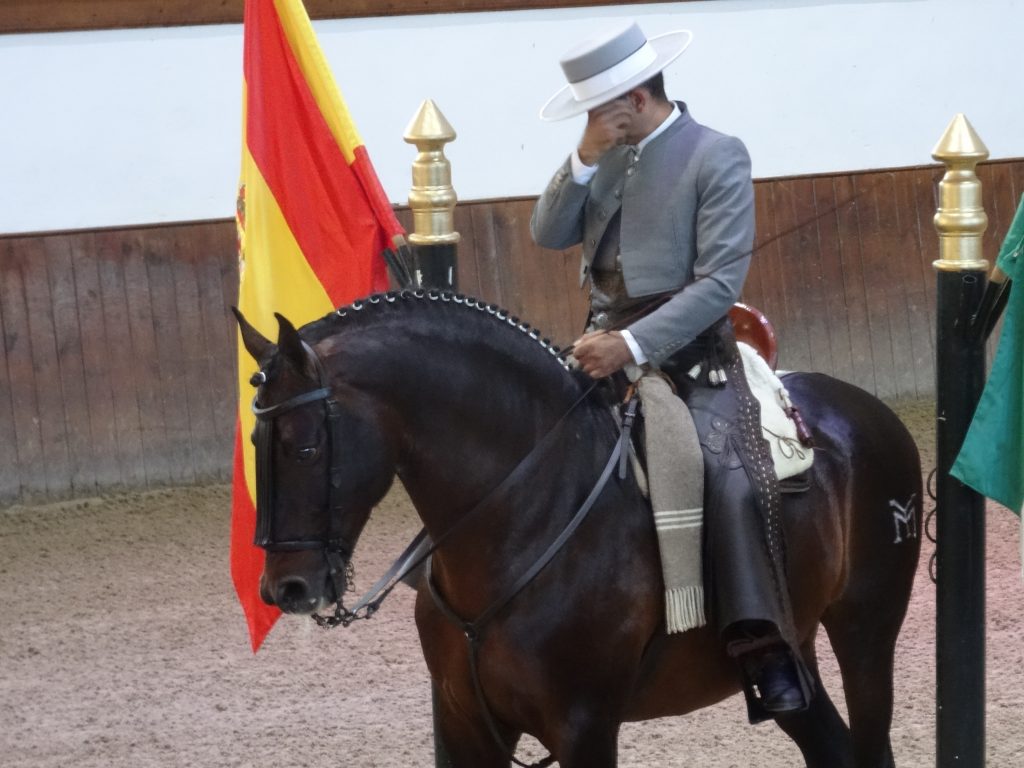
Start of the show. -
Flamenco and Mountain Villages
Just outside Seville are the Roman ruins of Italica. Worth a visit, we thought. Signage was pitifully lacking and when eventually located, everything was behind barricades … seemingly stopped mid restoration. With a bit of careful aiming between the chain link fence, we managed a few photos.
There was plenty of time before our check-in at Jerez, so with Cadiz quite close, we took a run down to the coast. The white, sandy beaches, pale blue ocean and palm trees looked very tropical … there were a few people swimming, but a toe dip determined it to be far too chilly to be enjoyable. For us anyway.
A late lunch overlooking the ocean seemed like a good idea … tall glasses of freshly squeezed orange juice and a flame-charred pizza straight from the oven, covered with peppers, black olives and an exceptionally good salami.
Parking is possibly going to be an issue in Jerez. Maria met us as we drove up the insanely narrow lane outside the apartment. There was no stopping of any kind here, but by scrunching the car hard against the opposite wall, we could quickly unload our bags and stuff, and with Maria’s and her friend’s help, lug them up three flights of stairs (there was no elevator) before Glen had to move the car. He was able to find parking a ten minute walk away, beside the Harvey’s Bristol Cream bodega. Lovely apartment with views of the town from the balcony … a picturesque church next door … and a pastry shop –Pastelaria Jesus – right downstairs! Hopefully the church’s blessing removes some of the calories.
The next morning was wash day … we were running out of clothes! There were washing lines inside the patio, and things soon dried in the sun and breeze.
That evening we booked a flamenco show at Tablao Puro Arte, purported to be the best in Jerez — the place where flamenco is said to have originated (although hotly disputed by Seville and Granada). The show was to begin at ten pm — we could have gone for the ‘tapas and wine’ deal beforehand, but as we had already eaten ours was a ‘drinks only’ ticket. People were just finishing up their food when we arrived but we were shown in, and wine was poured. Our table had a clear view of the stage . . . and there was an open space directly in front, with four chairs placed in a square, facing each other.
Lit candles for each table … the lights were dimmed … four darkened figures filed in, and sat in the chairs — two of them just inches from our table. A spotlight on the Cantao (singer) Luis Varga El Mono who threw out a raspy impassioned invitation with his voice … one of the dancers stood up with a toss of her head and responded with a stamp and rapid staccato of heels .. turning suddenly and staring disdainfully — apparently right through us! The other two dancers (male and female) responded in kind … each performance more emotional and intricate than the last. All this just feet from us – so close you could feel every stomp and breath. Incredible! Here’s a short video with some of the people we saw: https://hi-in.facebook.com/puroarteflamencojerez/videos/tablao-flamenco-puro-arte-seguimos-disfrutando-de-visitas-muy-ilustres-y-el-fin-/1743403579254969/
Action now moved to the stage. This time with a remarkable guitarist … the singer … and two dancers, who did the hand clapping and Oles of encouragement. The side curtains opened, and a Flamenca paused in the spotlight, then slowly and deliberately dragged her chair behind her across to the other side of the stage … staring at the audience all the while. A dramatic entry indeed! Her dance had a raw, gypsy edge to it … wild and abandoned one moment … controlled and precise the next.
The next dancer’s face and movements were so expressive you could read them like a book … lithe, flamboyant, cheeky. An amazing range. She had complete control of the long ruffled train on her dress.
The male dancer, though, was the true essence of Flamenco. His outfit made quite the statement … black pants, white jacket, long red scarf and white shoes with red toes and heels … but it was his performance which moved him to the next level. Every head movement, twist of the hand, click of the heel was a joy to watch. His feet a blur as he drifted across the stage, the beats ever changing . A true master. (He’s the younger man on the far left, with Luis Varga beside him)
Some of the nearby pueblos blancos are recommended as ‘must see’ … however pretty much ALL towns here are white, however some have obtained a reputation for being slightly more attractive. Of course this means busier with tourists too! We selected three which could be visited in a sort of loop. Arcos was first … spread along a high cliff, similar to Ronda, with quite a spectacular church and fortress on the hilltop. As expected it was busy, and the only parking was at the bottom of town — still we’re used to hills by now. Met two nuns on their way down from the convent — one with a guitar case like a backpack. The fortress was closed, but there was a good view over the fields and valley. One enterprising gentleman had a row of owls and raptors on a perch inside a kiosk-like tent. You could have your photograph taken with the bird of your choice sitting on your hand . . . only 10 euros. Poor birds looked fed up, and the Peregrine Falcon kept looking up longingly at the free birds wheeling overhead.
Ubrique had long been on my list, and it was not a disappointment. A high winding mountain road to get there — then around one corner — the whole town clustered brilliant white way down at the foot of the mountains. Here in Andalucia, Sundays are for the family … multi-generations gather for late lunch, taking up several tables.
Grandmothers with wheelies had pride of place … dogs lurked expectantly under tables .. kids played ball in the plaza … and everyone talked at once. Ubrique was no different. The whole centre street had become a pedestrian plaza with families and friends sitting at tables or on high stools around tall upright barrels used as tables. We nabbed a couple of chairs at a small Peruvian family restaurant down one side street, the owner rustled up a table. While we waited for our order (the poor kitchen staff were rushed off their feet) we sipped fresh, ice cold limeade, and people watched. The Peruvian stirfry was delicious, by the way. Ubrique is renowned for its leatherwork — apparently places like Gucci and Luis Vuitton source their leather from there … but being Sunday, the shops we saw were all closed.
It was gone four when we left and drove towards Grazalema on its mountain-face overlooking a deep wide valley . . . the ribbon of road looking tiny from up there. Not as crowded this late in the day. This is a big cheese making region – sheep and goat’s milk … so yes . . . . there was a Cheese Shop … or rather a queso tienda! Customers lined up three deep at the counter and out into the street.
We sat admiring the view and munching some crema-filled donuts (a kind of pattisserie cream) which turned out to be very tasty.
The sun was getting lower as we looped down hairpin bend after hairpin bend, and then up and over the next mountain ridge … in the distance you could see yet more mountain ranges disappearing into the darkening haze.
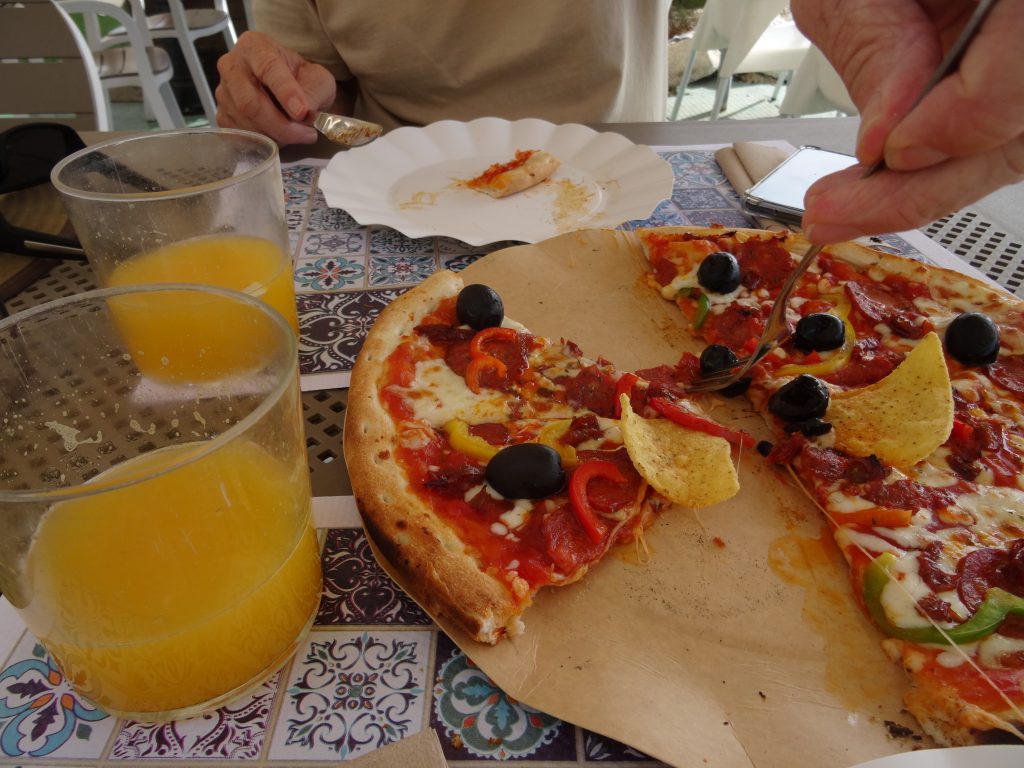
Unexpectedly delicious pizza and juice 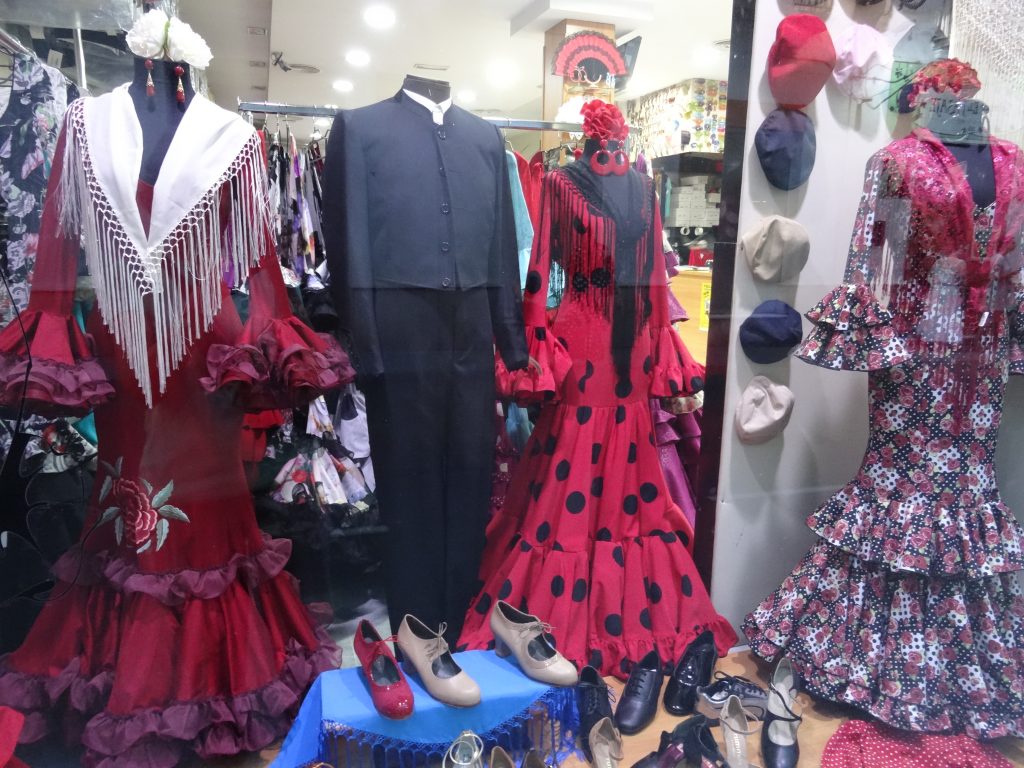
Beautiful Flamenco dresses 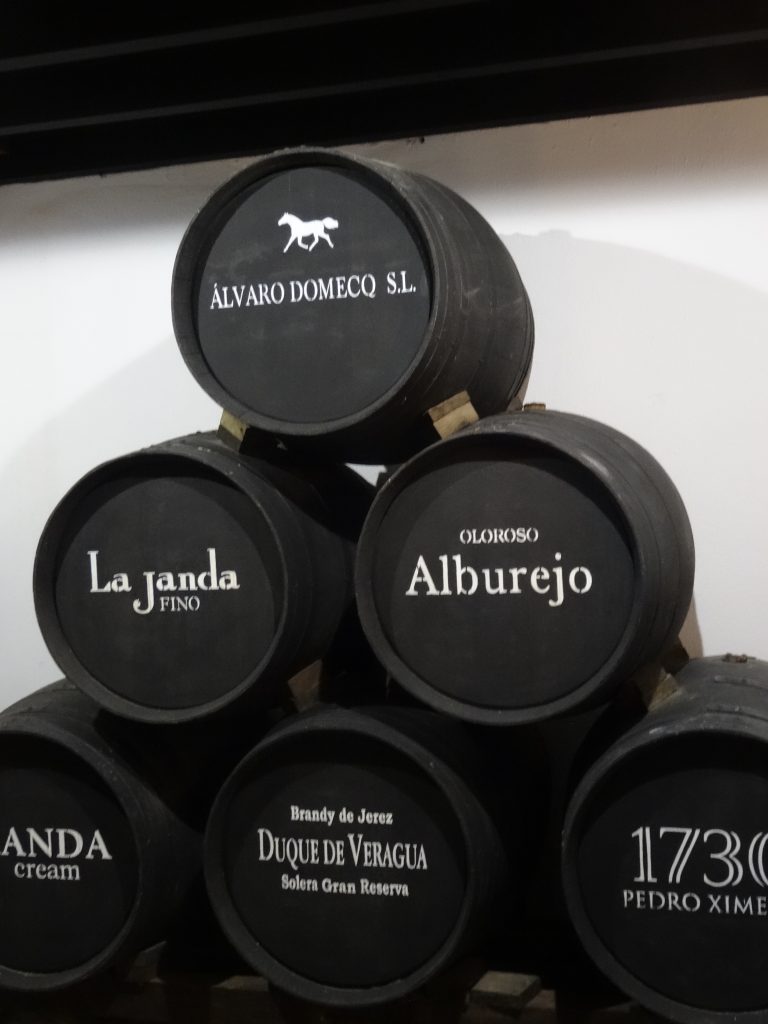
Flamenco Club 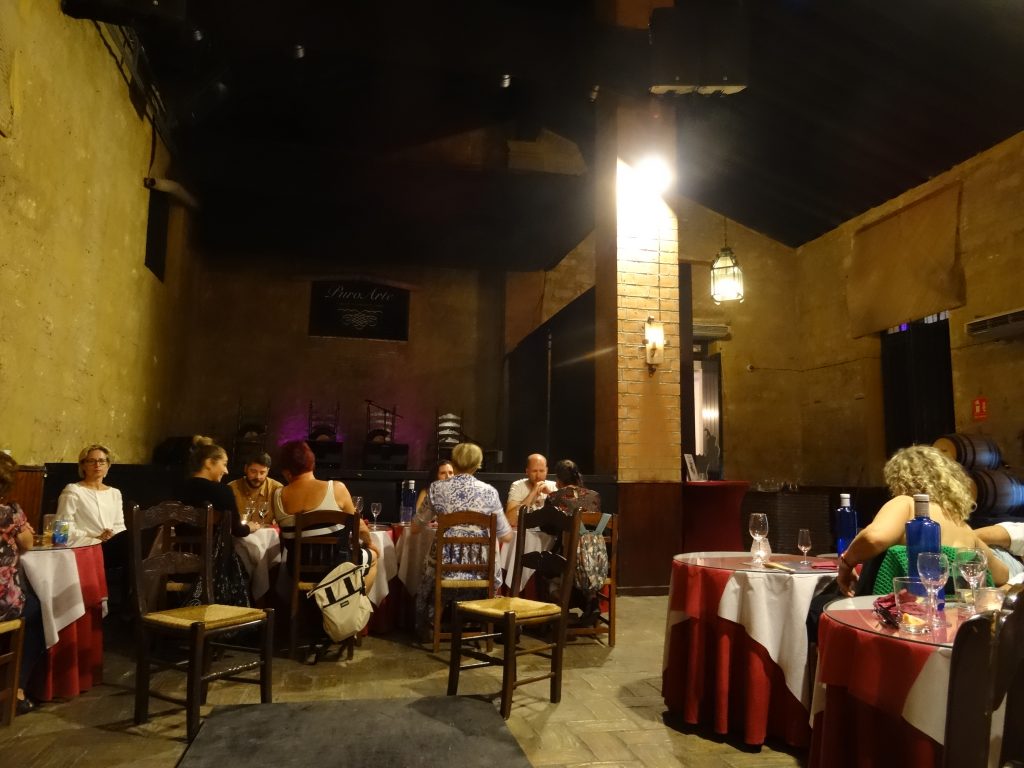
View from our table at Flamenco Tablao 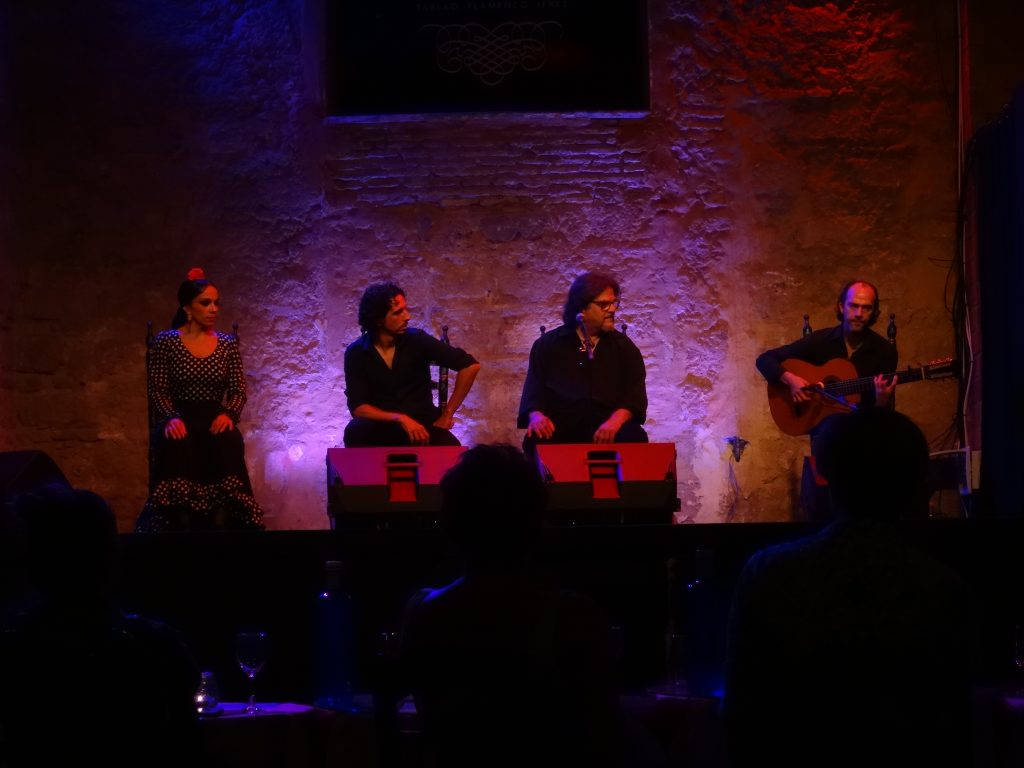
Cantores and guitar 
La Flamenca 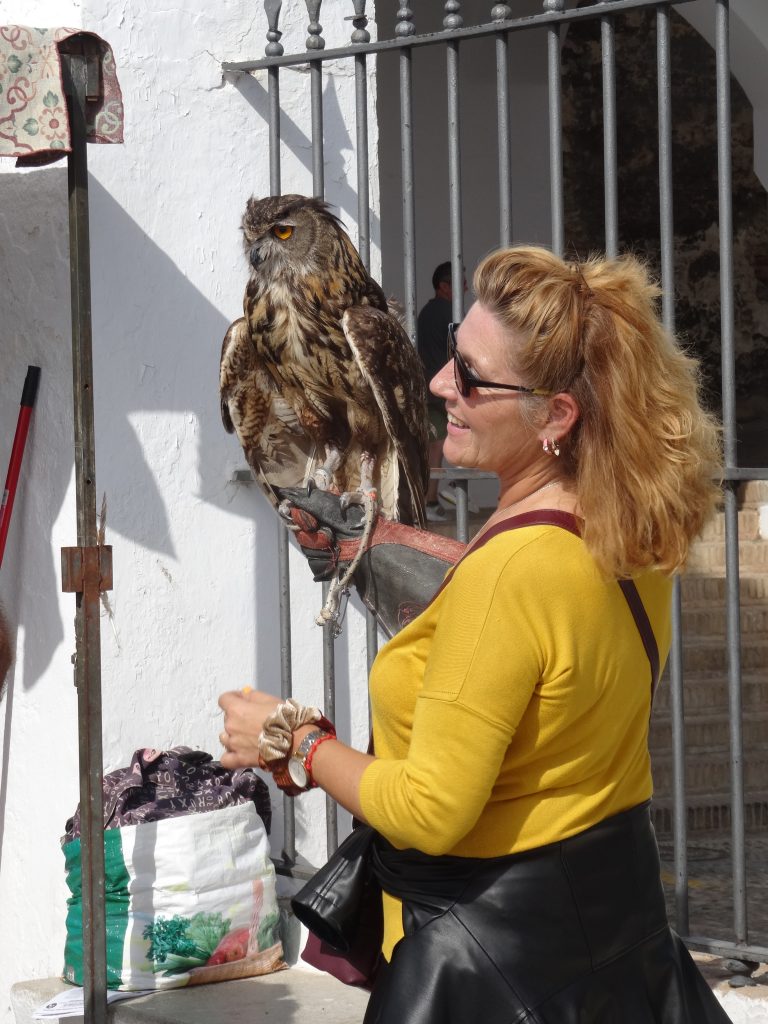
Captive Raptors at Arcos 
Arcos 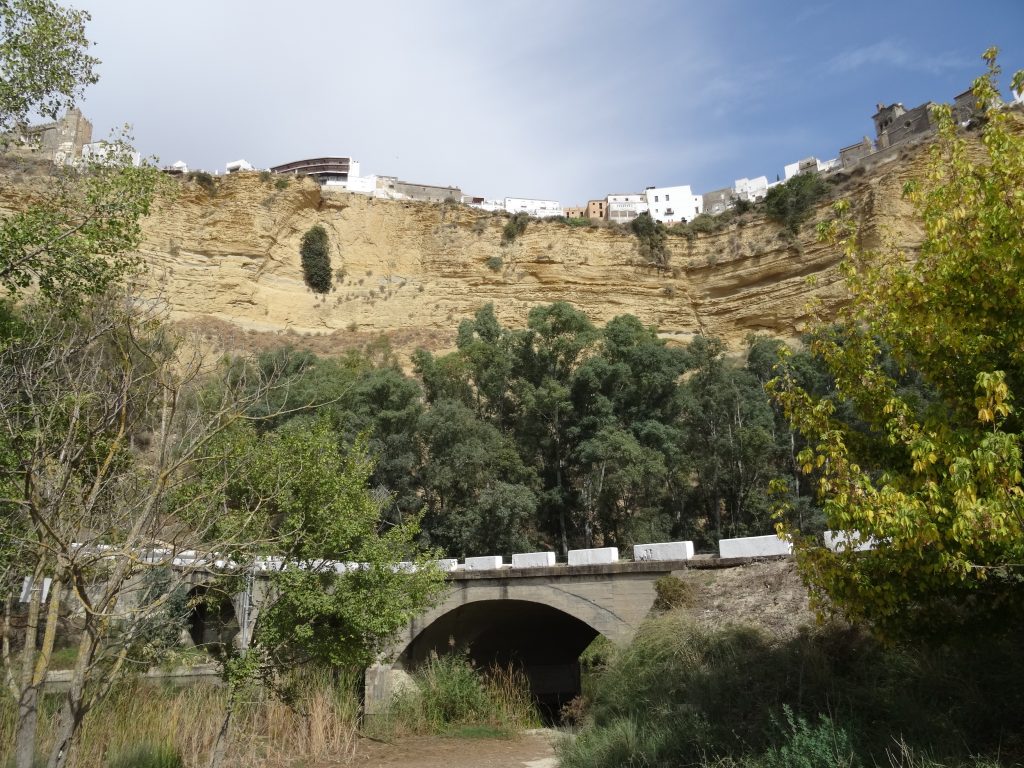
Cliffs at Arcos 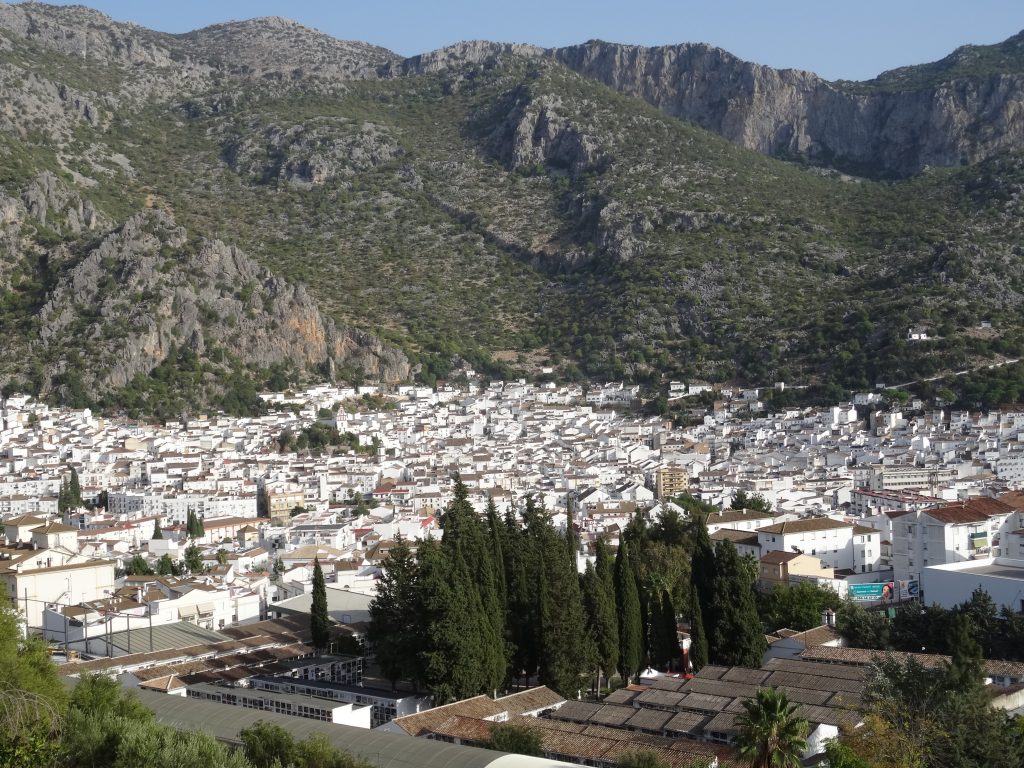
Ubrique 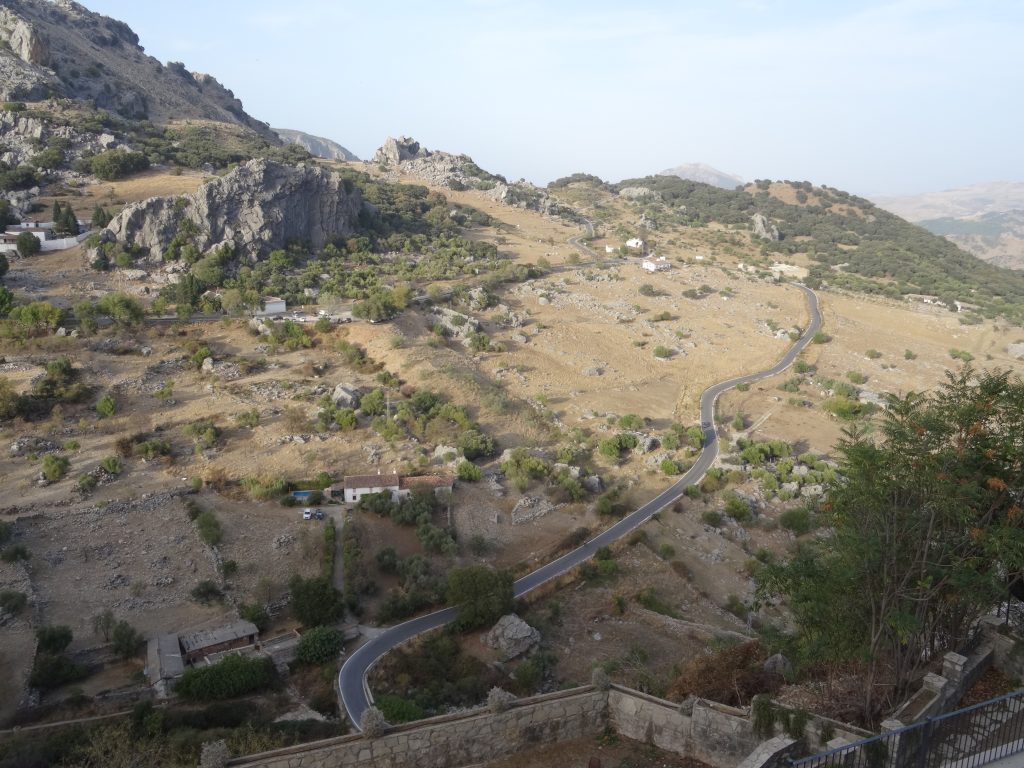
Road to Grazelema 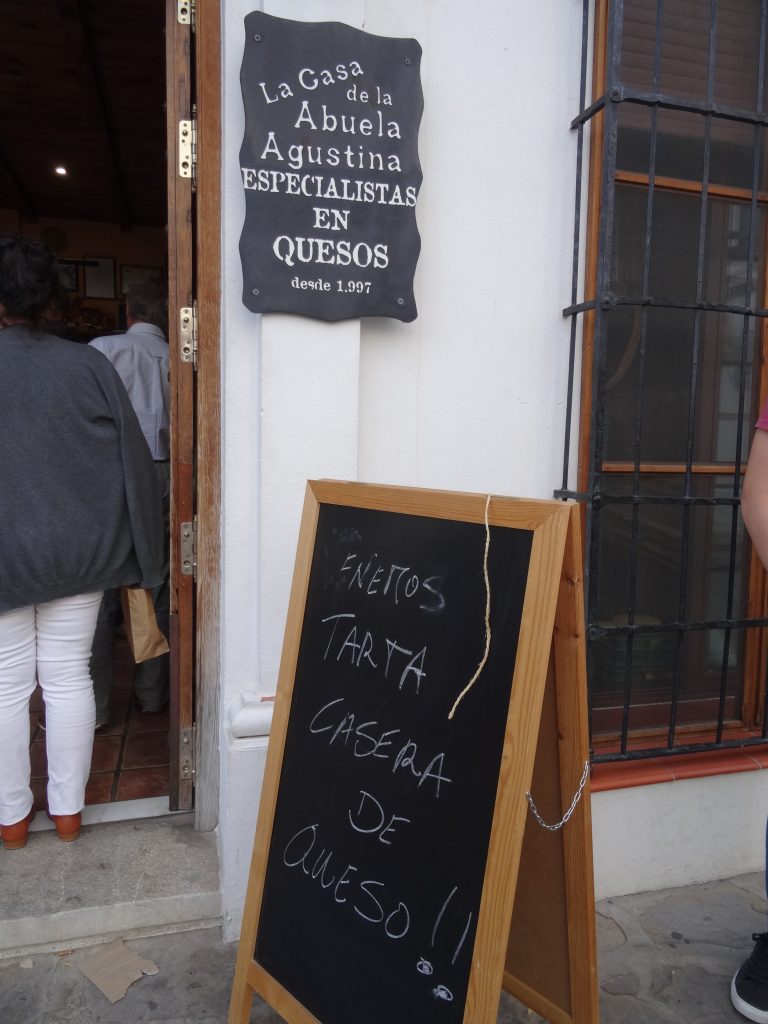
The Cheese shop, Grazelema 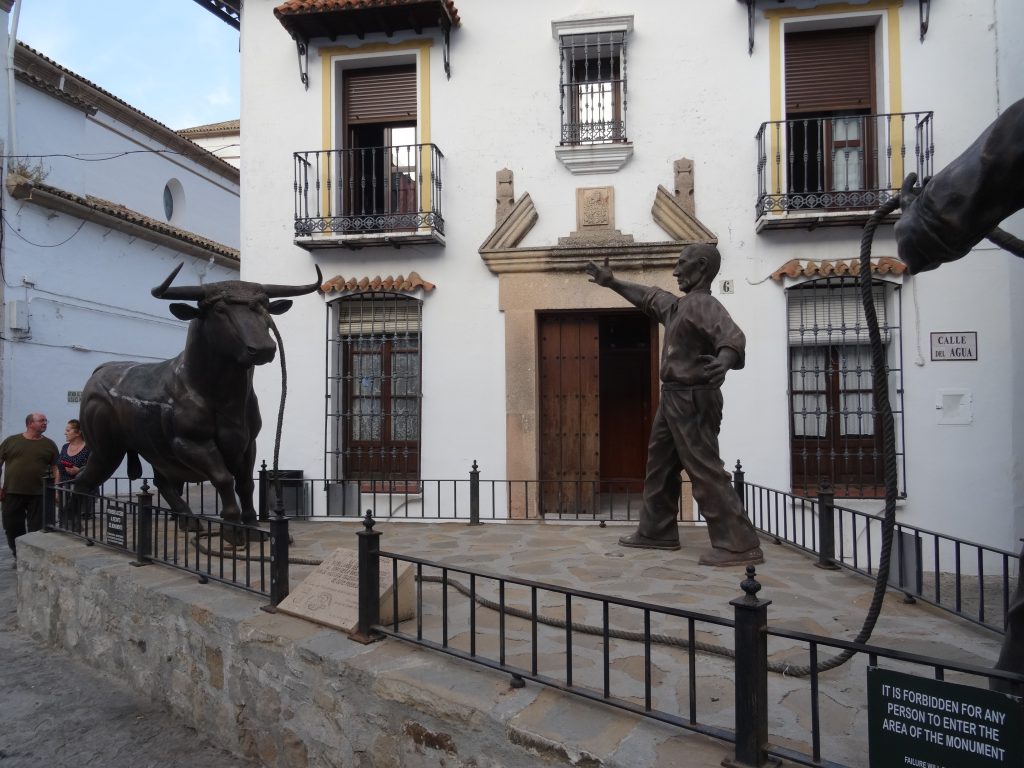
Grazelema -
Nobody expects … The Barber of Seville
Visits to markets are a must! They are the heartbeat of any thriving village, town or city. Vibrant … full of bustle and shouts … colour and smell — it almost grabs and pulls you inside. Fruits and vegetables arranged as carefully as any painted masterpiece — polished, turned, placed for best effect. The prized corner stalls have probably been run by the same family for decades. In Triana, their names and commodities are emblazoned in tile across the wall above. It’s a feast for the senses to just wander … although the temptation to buy something … anything … is overwhelming. Butchers … fishmongers … their counters gleaming
with an assortment of meat and fish we can only dream about in North America … Delicatessens with rows of whole Iberian jamon hanging tantalizingly (it’s a pleasure to watch the skill of slicing) … and a mind-boggling array of cured sausages and meats. This article gives you just a taste: https://viewfromlavila.com/2018/03/17/more-than-just-chorizo-a-guide-to-spanish-cold-meats/
And permeating everything are the heady aromas of roasting coffee, frying food … and freshly baked bread!
Surely, this must be one of the most photographed arches in all of Spain … Nobody expects the Spanish Inquisition! We saw no fewer than three people taking snaps in the space of as many minutes. Then, down a tiny, inauspicious lane, a doorway with spiraling red and blue sign — what I had been hoping for — The Barber of Seville! Glorious!
The Casa de Pilatos __ was worth a visit, although there was an unexpected event in progress when we arrived and it wouldn’t reopen for another hour (we caught a glimpse through the window of a woman in the most wonderful flame-orange flamenco dress , photographers and sound equipment). Wandering down a nearby street we uncovered just the thing to while away the time — a secluded outside alcove with two tables — and tiny coffee shop-cum-tea room attached. They certainly have an eclectic menu – anything from jamon, eggs and tapas, to churros, sandwiches and crepes. Perhaps our choice of lemon and sugar coated crepes and a cup of tea was a little unusual … but it worked. Thin, tangy and positively delicious. Proper loose tea, too.
Opening of the Pilatos was delayed just a bit … but it’s always interesting to watch people as they wait. There are the ones who stand patiently in line, chatting quietly … others seem to ‘expand’ into the space having loud conversations
among themselves or on their phones … then there are the impatient ones — pointedly looking at their watches, tutting loudly, and repeatedly checking with the ticket clerk. Some take the inconvenience as a normal happenstance – wandering off to find a place to sit, or look through their guidebook for their next stop. Always fun to guess nationalities just from observing … sometimes quite incorrectly, I might add.
Leaving the warren of narrow streets which are naturally shaded by the two or three storied buildings, the blast of heat was almost physical … there is a good 8-10 degree difference in temperature. An ice cream wouldn’t come amiss . . . . oh look, there’s an Heladeria on the corner! We chose two sorbets — mandarin and mango — in handmade cones. It was just like eating fruit right off the trees … and it should be mandatory to have cones made this way!
The city at night was fun … first the Cathedral and then on to Plaza de Espana. It was a warm, velvety evening and we had the place almost to ourselves — just a few people like us strolling through. It was even more impressive at night … the lights of the bridges reflected in the inky black water … the echoing clop of an occasional horse carriage.
Heading back over the Puente de Tirana for the last time — what did we see but two National Police cars pulled up haphazardly onto the sidewalk … so they could visit the Churros place across the street. Churros/Donuts – seems there’s no difference.
We have walked, cycled and eaten our way around Sevilla the last 4 days, and loved every minute. It has definitely won our hearts.
Now, on to Jerez.
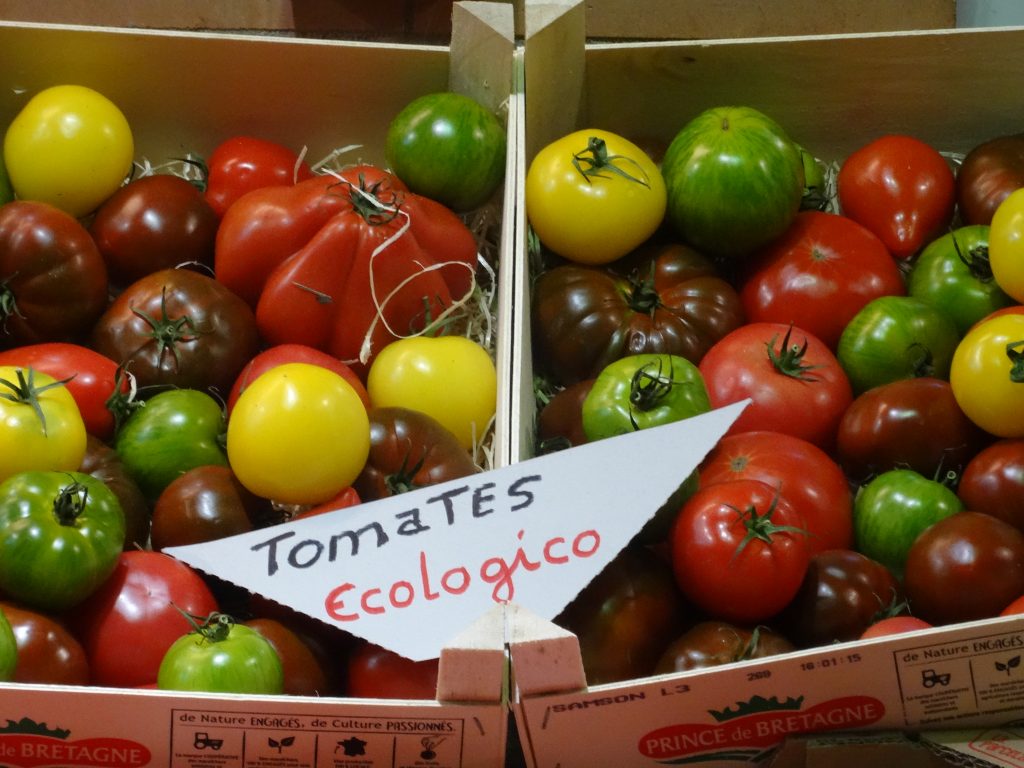
Look at those colours! 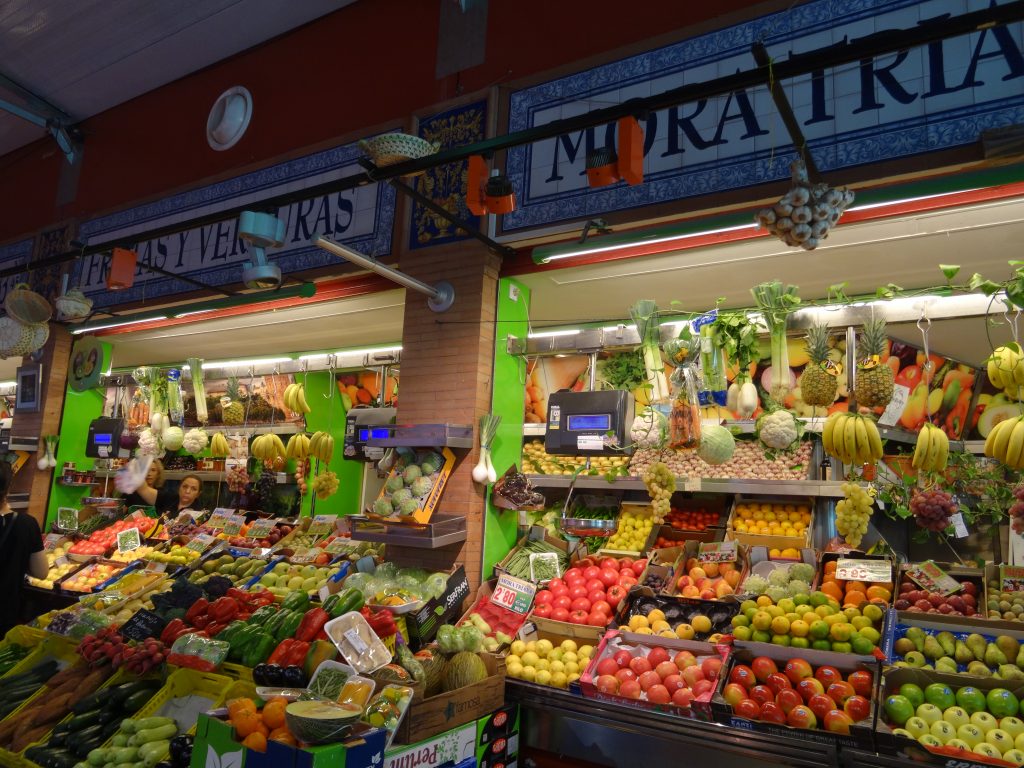
Frutas y Verduras 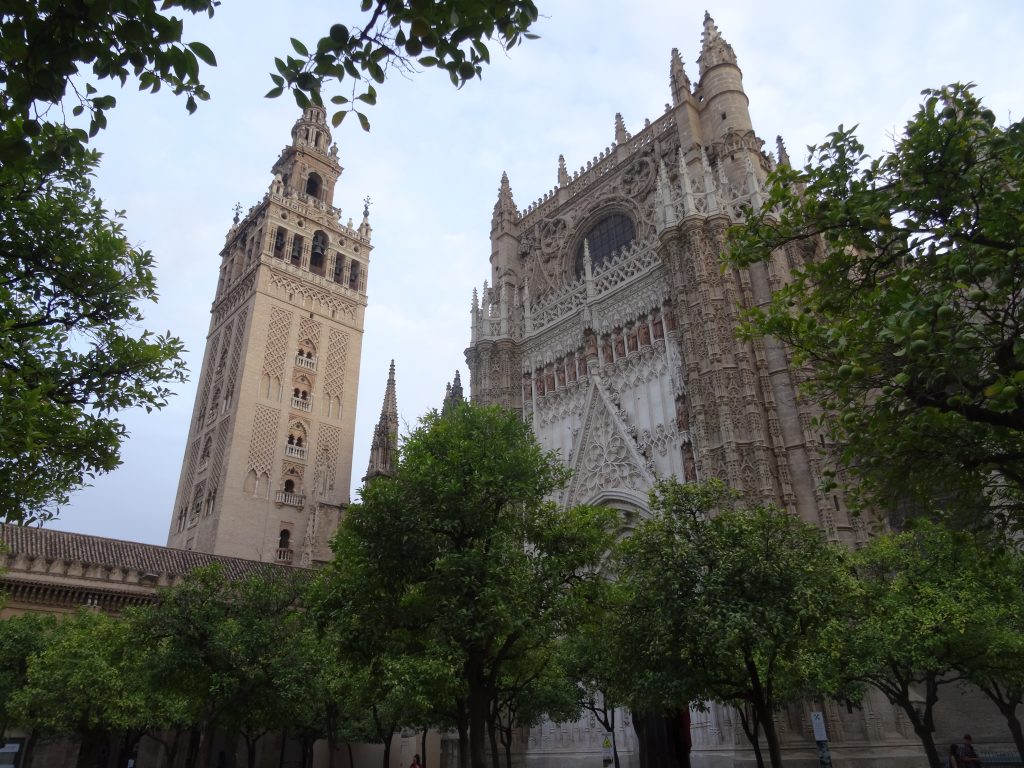
Seville Cathedral 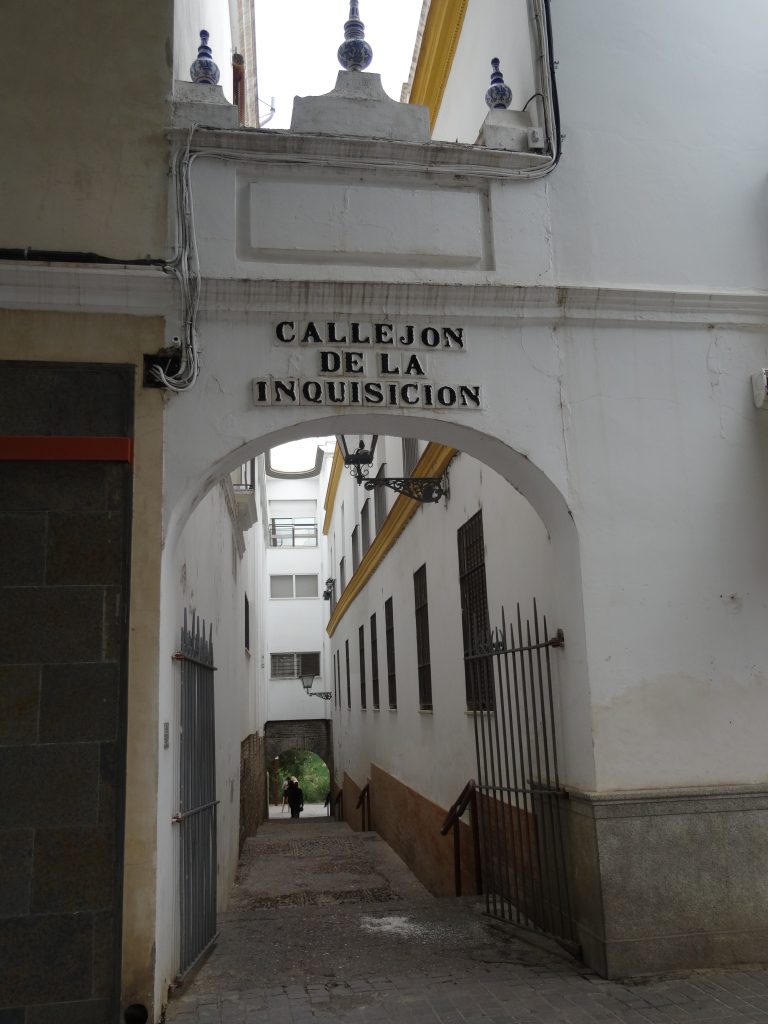
Nobody expects … 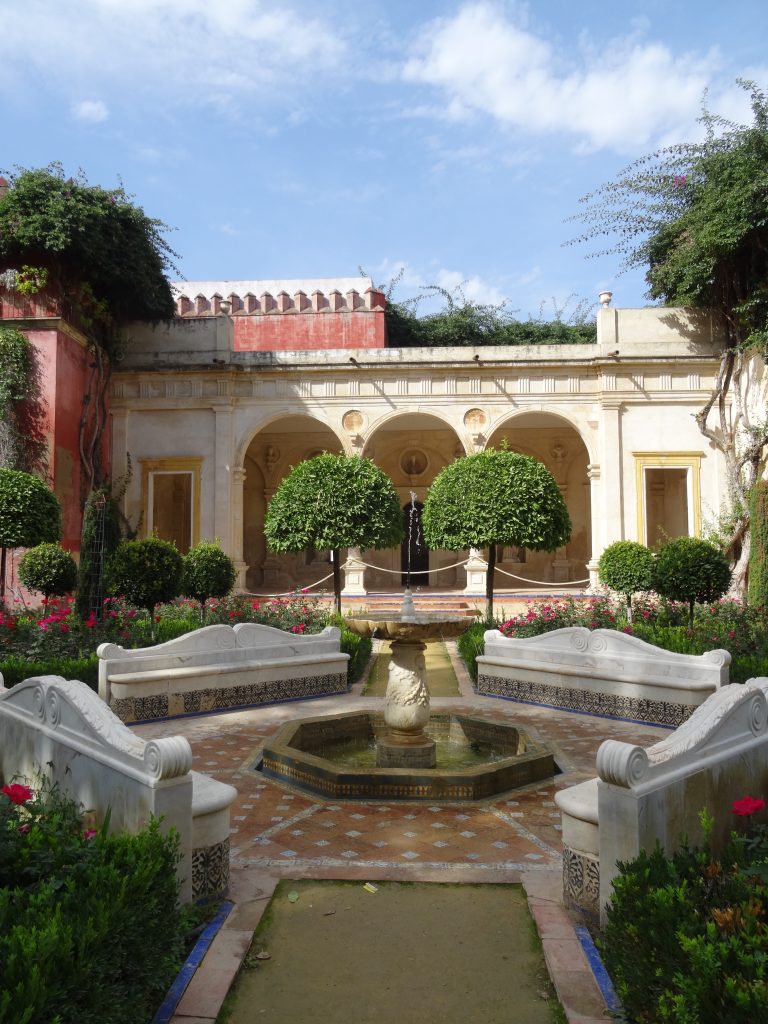
Plaza de Pilatos 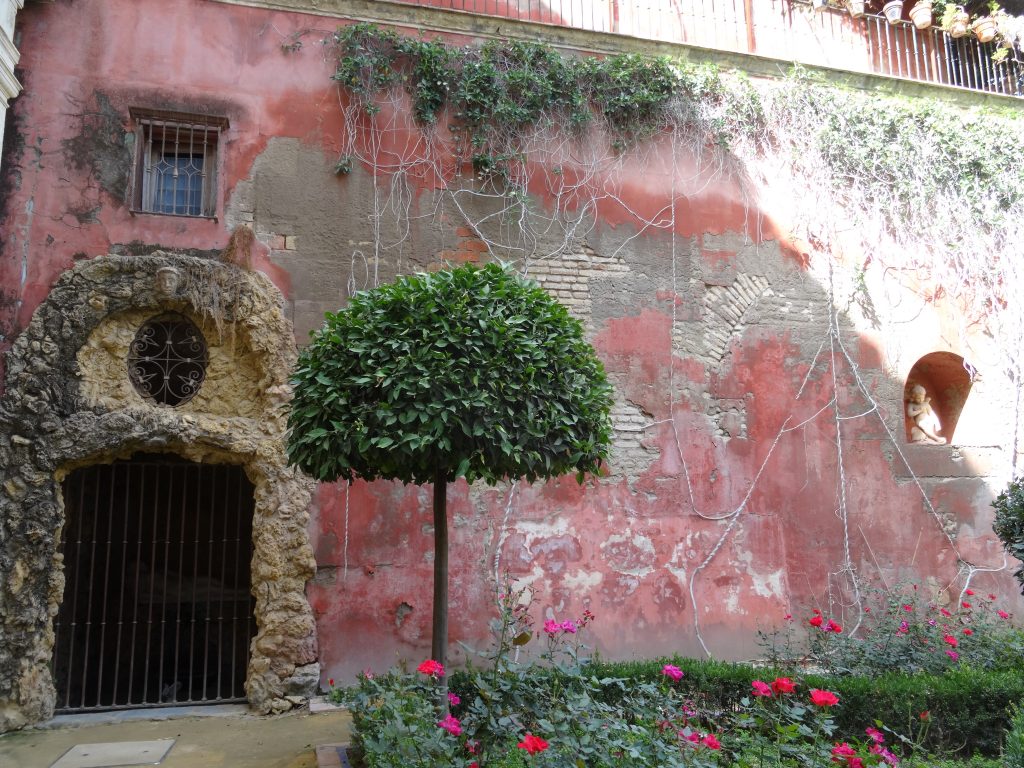
Plaza de Pilatos 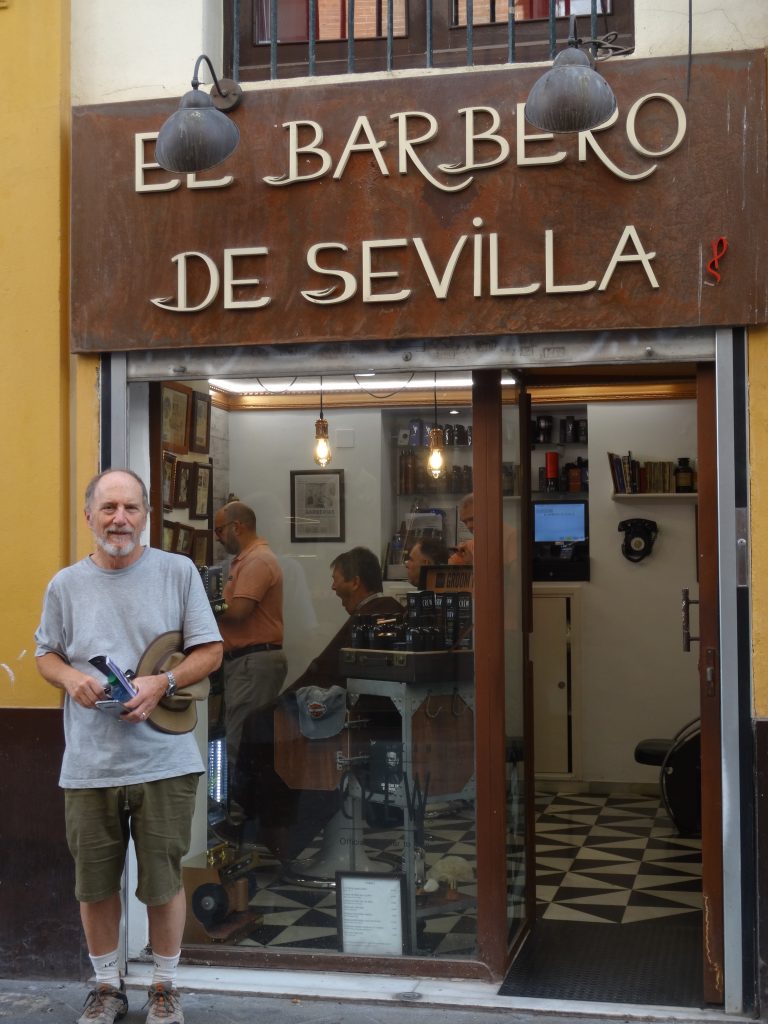
Of course there had to be one! 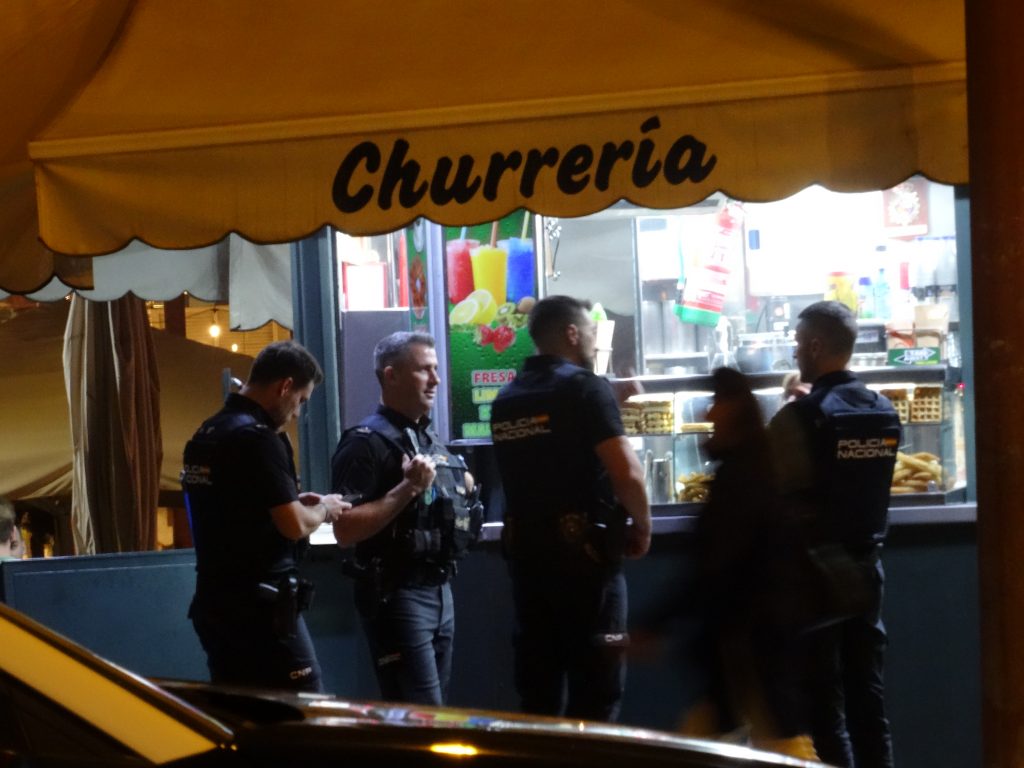
Cops the world over -
Bikes, Flamenco and Baklava
Having been captivated by Antequera … could Seville do the same, I wonder?
What better way to see a city, than by bike … so we rented two from Antonio. Seville has over 150 kms of bike routes throughout and surrounding the the old city centre, and they are well used by visitors and residents alike. For the most the most part lanes are painted green with bi-directional arrows , and often appear on both sides of the roads – separated from cars by a good solid curb. However, on cobblestones for example, the paths are marked with rows of shiny metal disks – not always easy to delineate (for bikers and pedestrians alike). Sometimes, you just have to share with pedestrians as the paths merge. Spanish drivers are courteous … pedestrians are not!
We started off cautiously, and headed for the huge park surrounding the Plaza de Espana https://es.wikipedia.org/wiki/Plaza_de_Espa%C3%B1a_(Sevilla)
Tree-filled, wide sandy avenues, grottos with waterfalls, rows of ducks sunning themselves on the mosaic sides of
water courses (not intended for such purpose!) … and no traffic other than bikes, horse-drawn carriages and people. Rounding a corner we skidded to a halt, as the splendor of the vast, curved edifice unfolded before our eyes. It is truly staggering. The roofs, every balustrade, bridge and the panels depicting all major towns and cities across the country are created in ceramic painted tiles made right here in Triana. Off to the right … having found the perfect acoustic alcove … sat a guitarist. Every classical note clear and sweet. We propped up the bikes
and listened. As we dropped a handful of coins into his case, I asked how long he had been playing guitar — 33 years. First Rock, then Blues and now Classical — he grinned as he gave a quick snippet of each. Such talent.
Riding closer for a look at that magnificent facade … there, under one of the protruding balconies … a flourish of impromptu flamenco. Staccato clapping of hands … a firey stamp, and toss of the head … a swirl of skirt … the swell and throb of the guitar and singer. They had gathered quite a crowd. Two ladies … obviously both flamencas at a younger age … joyfully swooped and spun in front of me. What a delight. As the music and dance ended with a final crescendo, it was discouraging to see how many people quickly melted away with nary a coin being shared … yet they’d been only too pleased to photograph and film the excellent performance. We’d originally rented the bikes for two hours — figuring we’d be tired by that point, but not so. A phone call to Antonio extended our time a further 4+ hours (remember, everything closes between 2:30 and 5:30 … even bike rentals!)
Leaving the safety of the gardens, we sallied forth in search of lunch. Yesterday we’d spotted a Lebanese restaurant right across the road from the University of Seville. The mouth-watering aromas wafting out of the kitchen necessitated further investigation. There was an outdoor table with room to park bikes right alongside. We settled on a Tabbouleh salad and lamb kebab wraps … and were not disappointed! Bursting with freshly-prepared herbs, vegetables and just the right amount of Bulgar wheat, and melt-in-the-mouth skewers of lamb in flatbreads. Oh my! And who could leave without trying even one of their baklava, so we didn’t – we had two. As we sat savouring our food, lineups of people waited patiently for an available table. We’d timed it just right.
Now, to wear off all those glorious calories … off we plunged into the turmoil of the busy streets that circumnavigate the city. Traffic thundered by just a few feet away … separated — but only just. The bike lanes thronged with commuters – both cyclists and electric scooters … overtaking, dodging in and out of the on-coming lane. Definitely kept brakes at the ready! Away from the river it’s less polished and more ‘lived in’ … there are fewer sidewalk cafes and more construction … a touch grubbier perhaps, but it’s more neighbourhood-orientated. Smaller, more intimate churches, bars and restaurants.
Back along the other side of the river … past a rather sad-looking Magic Island complex … presumably some sort of amusement park – complete with a defunct rocket from the European Space Agency – but with an air of neglect. Did it close up for the winter, or was it something more permanent?
By 4:30 it had become very muggy … we couldn’t return the bikes yet, so we found a shaded bench along the river bank and sat sipping our water while watching the river-life. One private yacht-for-rent could be heard long before it put in an appearance. With a captive audience of a dozen or so on the upper deck, two flamenco singer/guitarists – amplified to the maximum — wailed and warbled enthusiastically . What they lacked in talent, they made up for in volume. Forcing their audience (and people on the shore) to endure, with no hope of escape, as the boat drifted first upstream, then back down!
With bikes safely returned, we only had 20 minutes until our ticket time at the cathedral (we hadn’t planned on an all day bike tour when booking!). Weaving through the crowded streets with pedestrians heading determinedly towards drinks and food, we arrived with 5 minutes to spare . . . . but to the wrong entrance. The one we wanted was completely on the other side . . . and this building takes up an entire city block!
Tackling the tower first (it closes at 7:00) there were no steps this time, but a series of 37 upward slopes and right-angle turns … puff, puff. Great 360 views, and the tower still possesses it’s carillon of bells in all sizes. Surely they aren’t still used while people are up here? Just in case, we made sure to descend before the 7:00 pm cutoff. And just as well, too. Precisely on the hour a great clamour arose overhead as the smaller bells on all four sides rang out … as though the Gates of Hades had just opened. Talk about closing time! I bet anyone still up there would have been deaf for a week.
The interior of the cathedral was impressive in regards size and architecture, but it didn’t have the feeling and soul of Barcelona’s Sagrada. One very pleasant bonus to having a late tour, is the quiet and lack of other visitors. Time to sit and contemplate.
Wearily we trudged back across the bridge into Triana. It had been a long day … but lunch had been quite a while ago. Antonio, a native son of Triana, had highly recommended a bar which did the absolute BEST tapas. It was ten to eight when we arrived and the sign in the window quite clearly stated Cerrado … even though all the tables outside (but one) were occupied. As we stood undecided, an older senor pointed at the table and asked if we were taking it, his intentions of commandeering it were clear. In through the window we could see food being arranged on the counters in preparation of opening …. “no, no, no … esta ocupada!” … and we sat our bottoms down and waited with anticipation.
Fearing a repeat of the other night, we ordered with confidence — not wishing to appear dithery tourists. Beer first . . . then some tapas. Maybe something with vegetables – that salad mix might be good … and you can’t go wrong with lamb skewers. Er … in hindsight, what I thought was a salad consisting of radishes, beets, and zucchini was in actual fact an ‘either or’ selection. The radishes were very fresh, mind .. and perfectly seasoned with olive oil and salt … and they certainly cleared the palate (and the sinuses) <grin> Oh well, you can’t win ’em all! But the lamb! Goodness, what flavour – and cooked to perfection. I asked if they had flans, (we’ve been unable find find any yet!) but sadly no . . . so we ordered more tapas instead. Chipirones (baby squid) in green sauce (herbs). I don’t think either of us have had squid that tender before. What a day . . . bicycles, guitars, flamenco and outstanding food.
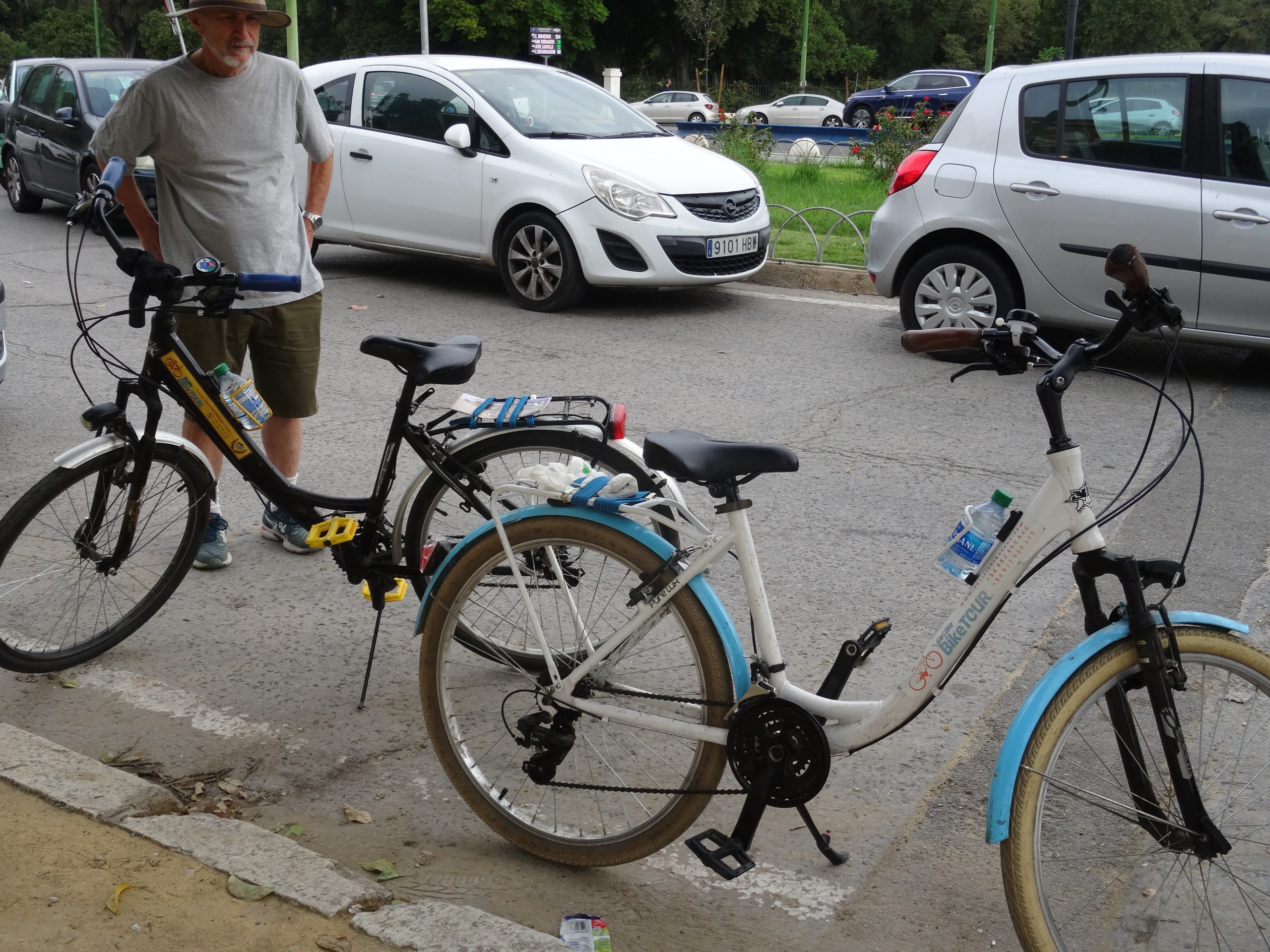
Bikes from Antonio 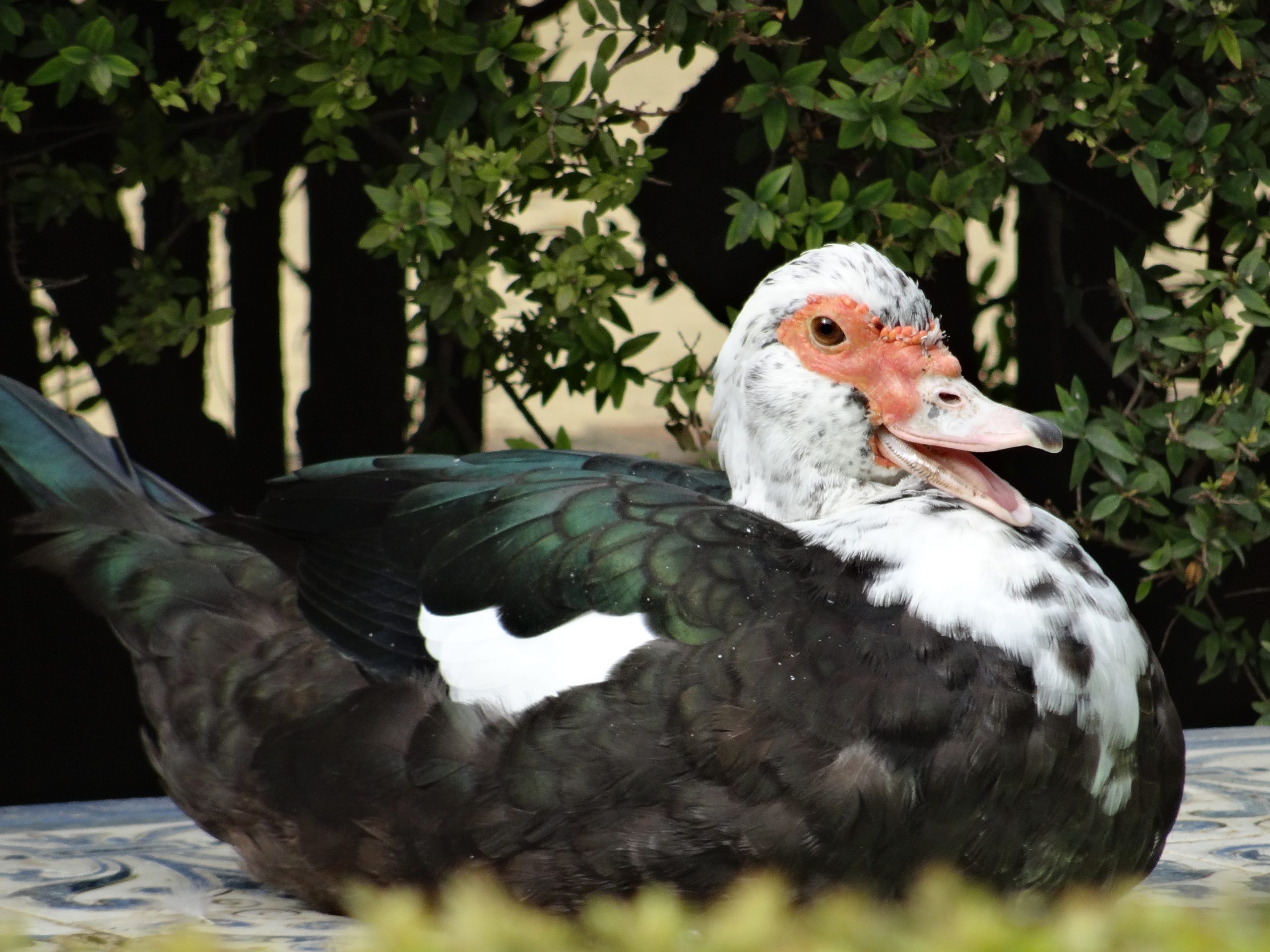
Happy Muscovy Duck 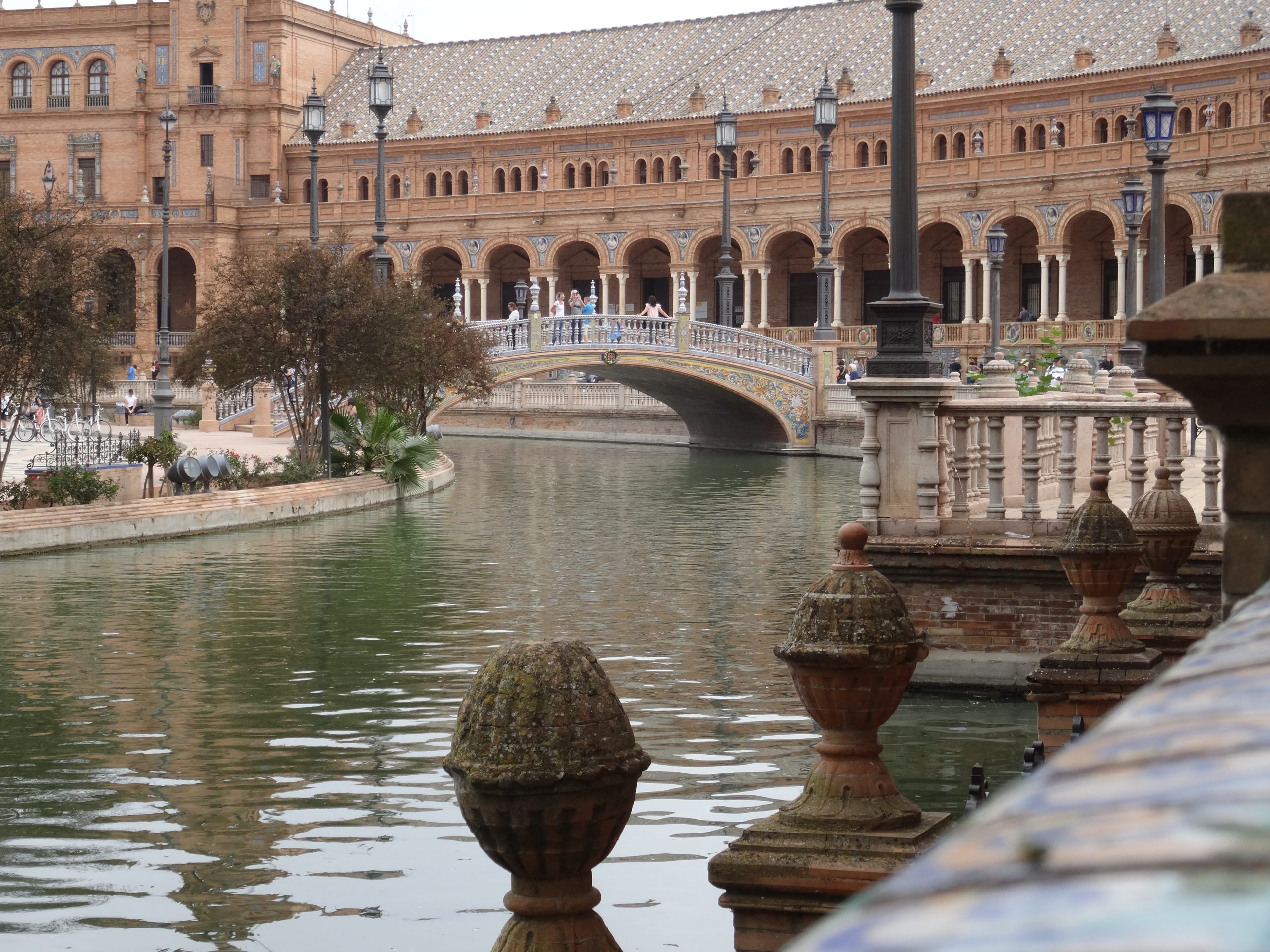
Plaza de Espana 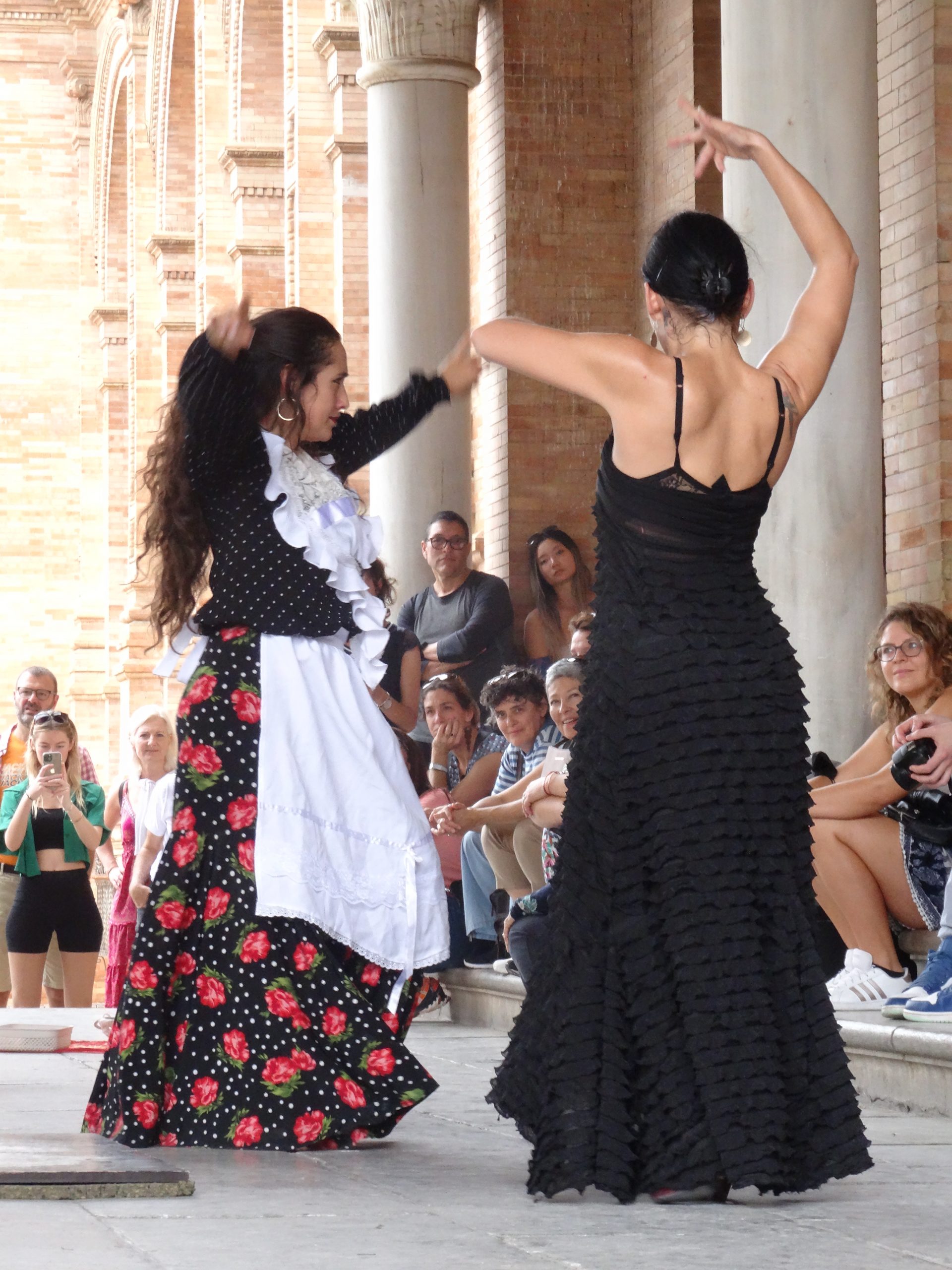
Las Flamencas 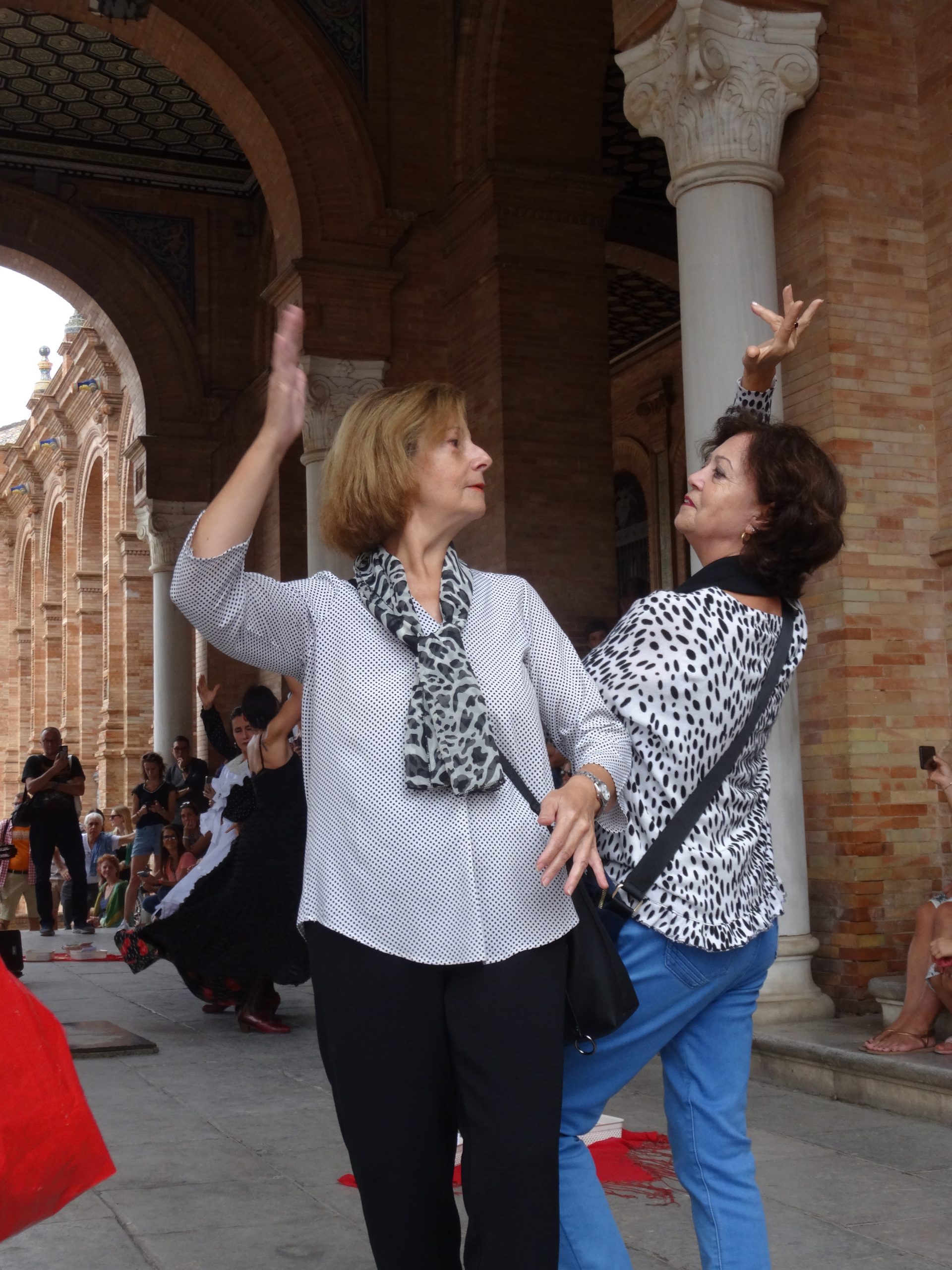
The Other Flamencas 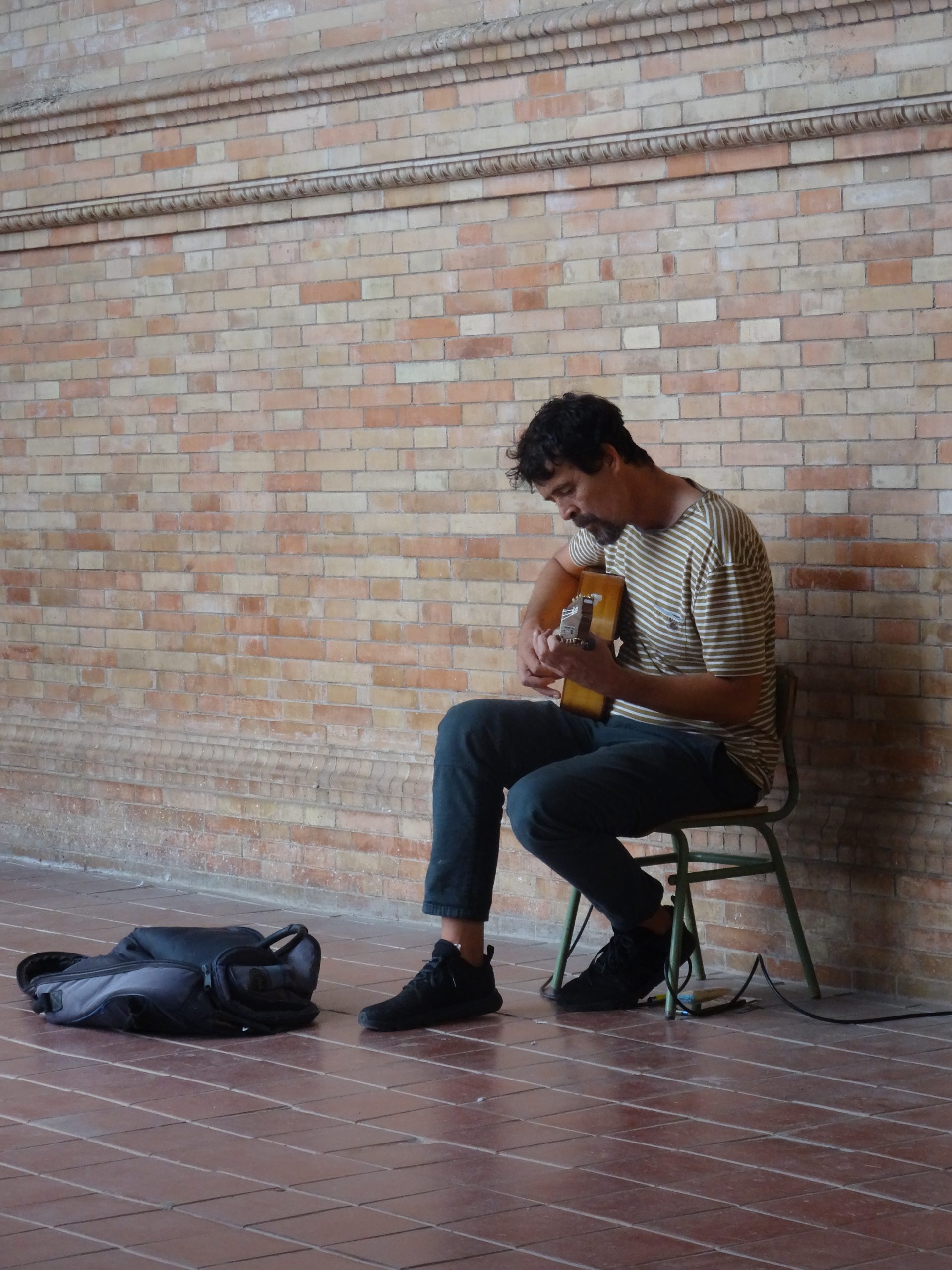
Guitarist at Plaza de Espana 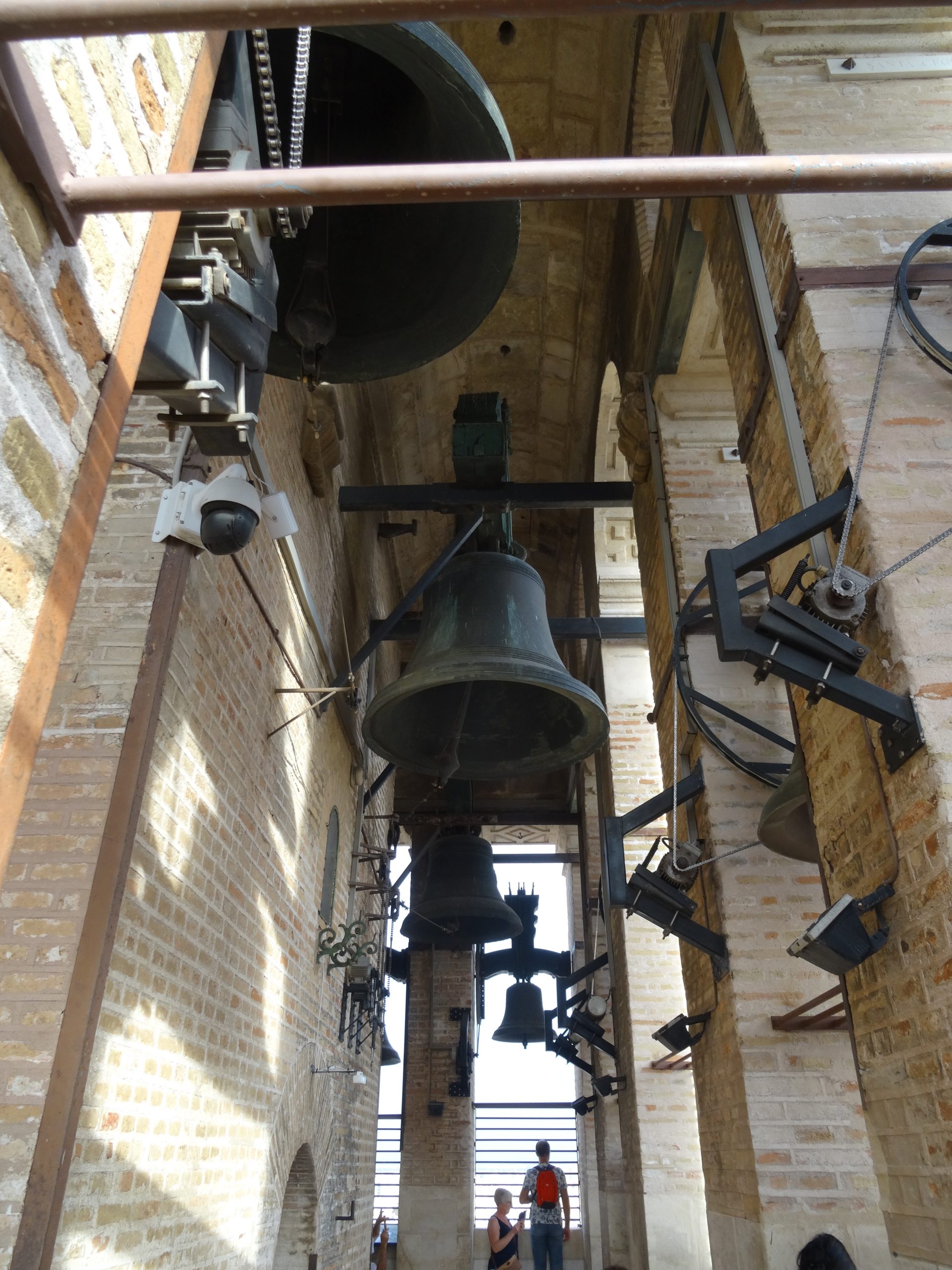
Just some of the Bells! 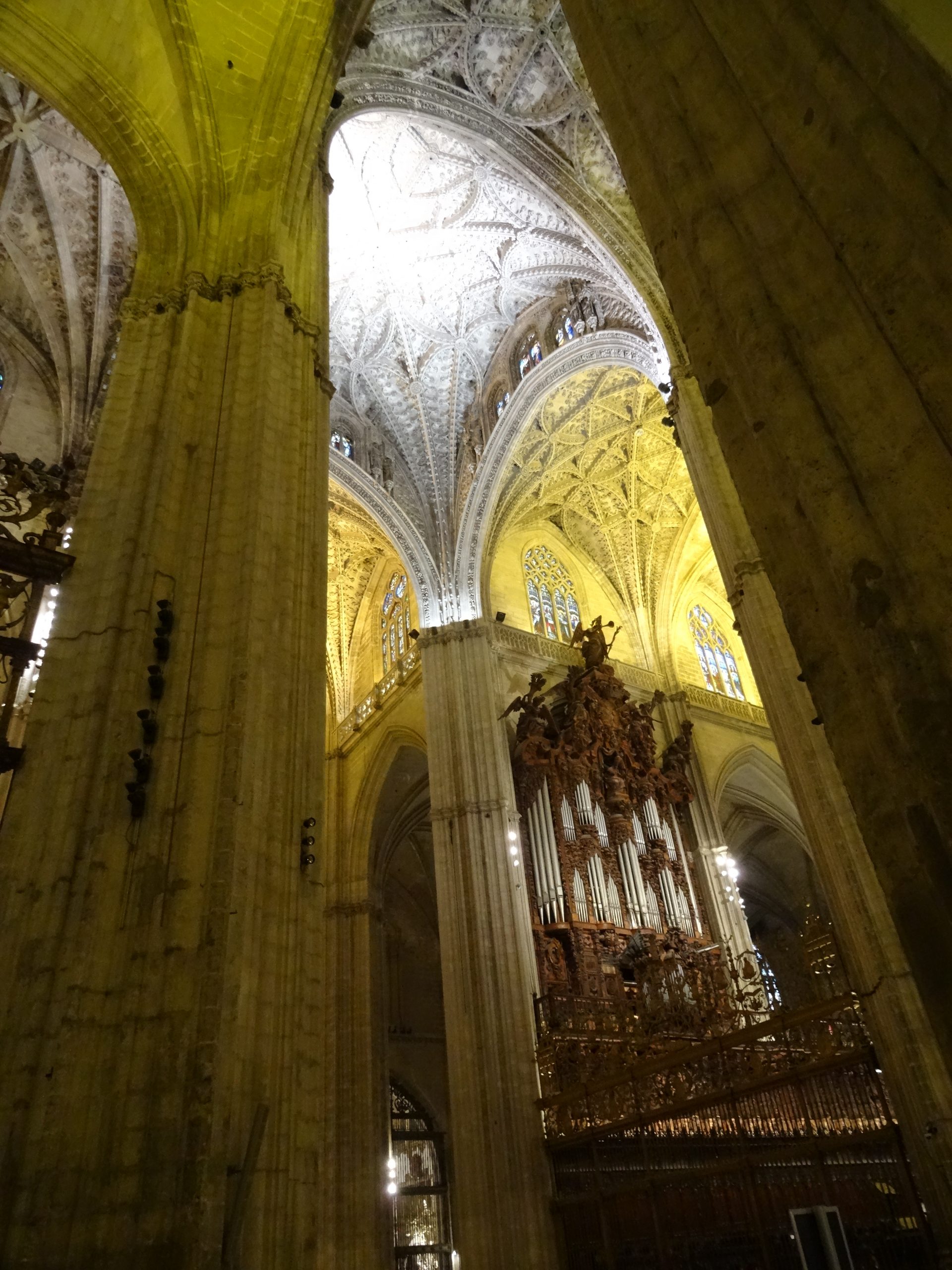
Seville’s Cathedral Arches -
Welcome to Sevilla
Just a short hour’s drive, and we were in Seville. We are staying in the Barrio de Triana – a neighbourhood just across the Guadalquivir River … considered by local Trianeros to be equally as important as the main city itself – if not more so! https://en.wikipedia.org/wiki/Triana,_Seville
Less touristy and famous for its potteries and the fabulously colourful tilework which can be seen on every building,
street sign church and bar. This is where locals live, work, eat, shop . . . and sit over beer and tapas with friends in the evening.
How lucky is that! … we found an honest-to-goodness legal street parking spot, and only a couple of blocks away. We retrieved the apartment keys from the bar on the corner,and trundled our ever-increasing possessions along noisy cobble stones (carefully avoiding the doggie deposits). With only four days to explore, we were determined not to waste a minute of them, so the bags were dumped, and we headed out.
The afternoon was perfect. A quick perusal of the market, but it was late in the day and most of the stalls were tightly shuttered — only the restaurant booths were still in full swing. The Puente de Triana (bridge) was right next door, spanning the green river which was a-buzz with virtually anything that could float and be propelled by human power… kayaks, canoes, rowing skulls, paddleboards — although I wonder about the wisdom of a ‘group paddleboard’!
Rowers from
Norway and Poland (I think) – judging from the flags on their oars – were training as coaches from the support boats broadcast instructions/encouragement via megaphones. People walked, sat and fished along the riverbank … and even collected after dark to picnic or chat, and watch the lights of the city.
We have tickets for the Alcazar tomorrow, but thought it prudent to scout out the route beforehand. In the Jardines de Murillo brilliant green Monk Parrots clustered in the palm trees – screeching noisily as they swooped from one tree to next. They make a huge racket when flocks of them roost for the night. The neighbouring apartment dwellers are less than enamoured. https://mappingspain.com/the-exotic-green-parrots-of-spain/
Aha … there, in the middle of the gardens, is the column commemorating Christopher Columbus (Cristóbal Colón)
with his ship The Santa Maria (La Gallega), his sponsors Ferdinand and Isabella, and the date 1492. This I remember from decades ago … a searingly hot day, where the pavement burned your feet right through sandals! Not quite so hot today – very pleasant if a little overcast.
For dinner we tried a nearby place recommended by the apartment host. We arrived suitably late, even by Spanish standards, but there were few people about. Perhaps because it was Monday? The bar – an homage to bullfighting – boasted a faded matador’s suit in a glass cabinet, various accouterments of the fight … and two massive mounted bulls’ heads on the wall … horns wickedly sharp … glass eyes glaring down accusingly. They were in a cordoned off area making photos difficult. A disinterested waiter brought beer, and then seemed to lose all interest as we deliberated on which tapas to try. We ordered more beers … these were banged down, dismissively. Stories of surly waiters abound, but this was our first encounter – perhaps he didn’t care for non-Spanish-speaking patrons. The food was … okay. The croquettas were not a patch on the ones in Barcelona … the mushroom and asparagus omelet was decidedly better,the sardinas con tomate mermelada however, were nicely smoked and very tasty. Too bad the camareros were jerks. Can’t win them all, I ‘spose.
On the other hand, the Alcazar was magnificent, and absolutely not to be missed! Busy, but not congested … phenomenal mosaics, intricately carved archways, ceilings and doors, immense tapestries, tiled water courses and vast tranquil gardens. You’d think we’d be a little complacent by now . . . but not here. This video gives you just a taste: https://youtu.be/XAp22X6-jtc
A reviving refreshment break of hot chocolate and a chicken empanada under the bougainvillea and wisteria arbor … with peacocks pecking around the tables instead of pigeons … children (and adults) were enthralled. We finally left after 4 hours … not because we’d seen everything, but because our feet needed a break.
Directly opposite, across the plaza is the magnificence that is Seville’s Cathedral with an almost never-ending line of horse-drawn carriages transporting visitors around the plaza and cathedral. The clip-clop of horse-shoes echoing off the walls.
On one of the main streets, a puppeteer with an entire orchestra – cleverly coordinated to the music — with a solo violinist taking centre stage
Further along the river bank a life-size replica of Ferdinand Magellan’s sailing ship – the Victoria – sat at anchor — this current vessel is a collaboration between Spain and Portugal to commemorate 500 years of his voyage around the world.
With a small supermercado and fruteria just a few doors down, we grabbed the makings of dinner for tonight … plump chicken thighs, red, yellow and green peppers, mushrooms, onions and tomatoes simmered with basil, oregano and a dash of piri piri chili powder. Not bad … with bread to soak up the sauce.
Ceramic Dome Group Paddleboard! Christopher Columbus Column Alcazar Seville Gates to garden, Alcazar Horse Carriage, one of dozens Puppet orchestra Replica of Magellan’s ship “Victoria” -
Carmona & A Courtyard of Oranges
Leaving the hazy skies around Antequera behind, you could see the cause … several processing plants in the distance emitting plumes of white smoke or steam which hung in the still air … an almost intangible hint of olive too.
I thought we’d seen olive groves, but driving the road towards Sevilla, nothing prepares you for production on this magnitude. Intense. Dense. Massive … often single operations as far as the eye can see, and the landscape is much flatter here. Sadly, none appear to be actively harvesting at the moment – that would have been a sight.
Carmona rises from the flat surrounding plain, rather like the bluffs of Ronda. The fields, now ploughed and empty, would have been a sea of yellow sunflowers in the summer. Guarding the gates is the fort and Puerta de Sevilla (Door of Seville) on the right … spectacular domed churches with their gleaming tiles on the left. Immediately one is plunged into a maze of one-way streets lined with parked cars, restaurants spilling their tables over the sidewalks, and people, in ones and twos, or entire groups Parking – as always – is an issue. Bright blue ‘P’ signs confidently direct you off … only to vanish into thin air. Streets all seem to have no parking symbols, which obviously no-one pays attention to. We took a chance and squeezed in. I think tow trucks would be hard pressed to maneuver here! (she said hopefully). Figuring it was easier to carry our lunch inside, we found a convenient bench and sat munching. People wandered by with a nod, smile or buenas … we even got wished buon provecho (bon apetit!). One salivating boxer dog sat down in the middle of the street, and had to be dragged away by embarrassed owners – to the merriment of all. There are literally too many churches to count. From our bench I can see four … and a convent. All gloriously different in style – the light is perfect for photos.
Views in all directions from the top of the fort … over the roofs, domes and spires … flags of Spain, Andalucia and Carmona snapping in the breeze. Tiny microcosms of daily life unfolding below in the rooftop gardens and washing lines. One obviously did washing for a nearby hotel or guesthouse, for there were lines and lines of dazzlingly white sheets all hung with red and green pegs … but tucked in behind, away from prying eyes, was a row of more personal ‘smalls’ … although Glen commented that these were not of a particularly small nature! Tsk!
Our next residence – for two nights – was just outside Carmona. Quite rural this time – a cortijo. https://en.wikipedia.org/wiki/Cortijo Laurance and her dogs welcomed us to the property with its rows and rows of orange and mandarin trees laden with ripening fruit, and edged with lavender plants. A large Swimming pool and deck surrounded by oleander and pine, and comfortable loungers, still too cold for a dip, but lovely to contemplate. Simple, rustic, peaceful setting … with a slight French flavour. It had rained heavily the day before we arrived, and the sudden moisture had brought an influx of hundreds and hundreds of red and black Squash Bugs. https://en.wikipedia.org/wiki/Corizus_hyoscyami Inoffensive, slow-moving, and thankfully non-smelly when squashed, they littered the ground and climbed the walls … for the most part remaining outside – although the odd one trundled inside when the door was open, and unceremoniously squished. They had mostly disappeared the following day. Three large dogs, of indeterminate parentage, could most often be found either side of the big wrought-iron gates to the courtyard – with the best view of any incoming visitor (real or imagined) … or suddenly beside you, peering earnestly into your face requesting a scratch behind the ear. One of the two cats – jet black and agile – had perfected the knack of following you inside, like a shadow … and had to be shooed outside again.
One of the days we are here is Sunday, so we brought enough food with us. The Spaghetti went perfectly with the bottle of red wine which Laurance had thoughtfully left us.
In a nearby out-building, Laurance had set up a big copper still . . . No… not what you’re thinking!! This was for distilling essential oils from the lavender and orange peel and flowers which she provided for perfumes and cosmetics.
Famous Sunflowers (not while we were here) Flags over Carmona Puerta de Seville One of MANY churches Ripening Oranges Our Patio Pool side -
A Farewell to Antequera
Olive Oil:
With olive trees as far as the eye can see in every direction it occurred to me – just how much olive oil does Spain produce? 50% of the world’s olive oil and over three times as much as Italy, Greece or Tunisia. That means that one out of every two bottles of oil sold in the world contains the Spanish product! There are more than 250 million olive trees throughout the country, Andalucía grows 75% of them – mainly in the Granada, Malaga and Cordoba regions – with Jaén considered the World’s capital. It’s doubtful harvesting is done the old fashioned way any more – beating the trees with sticks to loosen the fruit into waiting nets. Now they have machines which enfold the tree with something rather like an upside down umbrella and then pneumatically vibrate the fruit loose. Still labour-intensive though. I believe some places use low-flying helicopters to shake the trees.Hidden Entrances:
Behind every stout, no-nonsense door (or cloth curtain) along every street, lies a hidden gem . . . beautifully tiled entry ways … each using a different colour and pattern. Some go for the plain and simple look with perhaps a potted plant or two … others are more elaborate or striking in appearance, often with ornate, wrought-iron gates leading into the house instead of just wood.All doorways also have an indispensable heavy cloth curtain. First thing in the morning, the outer doors are opened, doorsteps are swept and washed, and curtains are pulled across – the perfect answer for both ventilation and privacy, while still having a friendly, approachable attitude should the neighbours want to stop by. Let me tell you, by the end of the first week I too was washing the front doorstep … I certainly didn’t want the local senoras tutting and rolling their eyes as they went past.
Starlings:
As dusk descends, flocks of Spotless Starlings gather to roost in the big, cloud-like pines around the square. The volume of sound is indescribable … a melodious symphony of whistles, flutes and trills … you can hear them as you drive by – with the windows up! I’d never even heard of Spotless Starlings before now, but like all starlings they are clever mimics and have a diverse repertoire. The city has wisely removed park benches from under the trees!Iglesia del Carmen:
There are multiple churches and convents throughout Antequera, but the Church of Carmen is a particularly lovely one. Not much to look at on the outside … inside there are the usual niches decorated in gold, commemorating various saints, however it is the intricately carved nave and altar that are quite remarkable.
The Museum of the city of Antequera was a hidden gem. Spread over three floors it contained a staggering display of the history of the area — this stuff is truly UNESCO quality. Pottery, frescos, jewellry, paintings, grave sites. Completely unexpected.
La Comida:
Before leaving Antequera we knew we’d have to visit two places. One we had walked past so many times … Cafe Baraka . . . tables and chairs under the spreading shade of an unknown tree across the street. Food is dashed across from the kitchen by nimble-footed servers. We had a very civilized late lunch, watching the world go by . . . a dish of green olives and two small cervesas to start, followed by sizzlingly hot lagostinas (large prawns) in spicy olive oil with bread for dipping. Oh my!
Our last evening was saved for Meson Adarve (if you Google Meson Adarve, Antequera, and then click on the ‘menu’ there are photos of the food) … a family-run restaurant. Only a handful of tables, so reservations were a must. We stopped by that afternoon to inquire … there was an intake of breath and pursing of lips as Juan contemplated his phone and counted that night’s bookings. A pause, and then “Sí, una mesa para dos” … YES, we were in for 8:30.
We walked through the busy, lit streets for the last time … dodging scooters and stepping into doorways to avoid cars. There were no menus … all dishes were written on blackboards on the walls … verduras (vegetables), carnes (meats) and pescados (fish). We settled on a mango and prawn salad with Rabos de toro (oxtail stew) to follow. The local mangos are something special – perhaps it’s because they are allowed to ripen on the trees, or the flavour is different, whatever the case, these were exceptional … and in combination with the prawns, mix of greens and subtle dressing – this was a dish NOT to be missed. Then the Rabo … slowly cooked for hours till it was fall-off-the-bone tender in its own gravy … served with the traditional crisply golden potato chips. Thank goodness there was bread for mopping … it would be a sin to miss any of that sauce.
There was no room for dessert … not even a shared cheesecake … but the son brought us tiny glasses of chilled licor de limón as a digestif. Very pleasant. A message from the restaurant states that nothing is ultraprocessed or precooked – here you eat as God gave/provided.
For some glorious photos of places round Antequera do have a look at this site:
Guide To Antequera, Best Things To Do In The “Florence of Andalusia”
Hidden Entrances Each tiled entrance is different Iglesia del Carmen From the museum From the museum From the museum Olives with everything – yum Sizzling Lagostinas Servers on a break Mango & Prawn Salad Evening chat with neighbours -
Dung Beetles, Dolmens and Lobos
There’s a lovely hiking trail in the hills overlooking Antequera – almost four kilometers of relatively flat, rock-strewn sandy path. It meanders its way past the remains of 17 Roman Arquillas – a system which carried water into town, while providing stunning views over the town and Peña de los Enamorados one way … tree-covered hills, farms and a
golf course (!) the other. The brilliant green of the fairways look totally out of place in an otherwise arid-looking landscape, but at least they have built two large reservoirs/rain catchment areas for watering the grass. The morning’s cloudburst must have done wonders in replenishing them. There were still a couple of puddles along the trail, but the sandy soil had sucked up the moisture almost immediately. Curious patches of black, polka-dot holes edged the path every few steps … a closer look revealed busy colonies of ants, industriously clearing out their underground tunnels after the deluge. No anthills visible … just a scattering of small, black holes like openings in a pepperpot. Careful where you stand when taking photos – the much larger guard ants had particularly large pincers … and held them aloft, menacingly!
Further along, a glossy black beetle – totally impervious to the ant currently investigating its leg – trundled along like an armoured tank. Is that …? Yes … it IS a dung beetle! We used to see lots of them in the dunes along the coast, rolling balls of dung three or four times their size … the spheres looking for all the world like sugar=coated chocolate truffles! Occasionally, they’d lose control of their prize, and have to cling on tightly as they both rolled to the bottom of the dip … necessitating another uphill climb. Well, there was plenty of ‘dung’ at the beginning of the trail — it seems people bring their BIG dogs up here for walks! Great video: https://youtu.be/I1RHmSm36aE
At the end of the trail is a former convent – now turned posh hotel and restaurant – Hotel Magdalena. And what a glorious locale. Gardens filled with banks of flowering rosemary – smelling wonderfully resinous when brushed against. Mauve and Magenta bougainvillea draped – oh so casually – over rock walls, bushes of pink and white Oleander lined the driveway, olive trees laden with ripening bright green olives and the distant valleys and smoke-gray mountains provided the perfect backdrop.
A twenty minute walk from where we’re staying, and just on the edge of town, are two of the Dolmens. Ancient underground monuments – the earliest dating back 5000-6000 years and consisting of gigantic slabs making up the walls and roof. The cut edges are remarkably precise and It’s hard to imagine how those massive roof slabs could be moved into place. It was only after visiting the Antequera museum that we found out the secret … they lay the roof pieces on the ground first and then excavated the cavern underneath … reinforcing with vertical pillars as
they went. Very clever. https://www.andalucia.org/en/antequera-cultural-tourism-dolmen-de-menga These two dolmens are aligned in some way with the mountain La Peña Enamorada – especially during the summer and winter solstices . . . there is a large sundial for just this purpose.
At the interpretation centre, a photo panorama took up an entire wall, however two middle-aged couples hogged the whole display. Pictures were taken of one wife … facing this way … then the other … with arms outstretched … standing in the centre. Repeated with the other wife . . . then one couple together . . . and t’other. ARGHHHH . . . how many photos of this were they actually going to look at when they got home!! People walked out in disgust, but it didn’t make any impression with these four. We left them to it and enjoyed the monuments.
The Roman era Dolman is considerably younger – a mere 2,000 years old, and set some distance away from the others. The construction is vastly different though – small clay bricks create the entrance tunnel and circular, domed roof. Significantly easier to construct, I would imagine.
Los Lobos Park sits at the foot of El Torcal. https://www.lobopark.com/ Only open from Thursday to
Sunday, the tours have to be booked ahead and each is just over an hour long. The co-owner, Daniel, worked for many years studying dogs and training them for police and military services, but about 20 years ago he became interested in creating a specialized park where Tundra, Timber and the endangered Iberian wolves could establish packs and live out their lives in as normal a setting as possible. Iberian wolves have been hunted to extinction here in Andalucia and only exist in the wild in northern Spain. The park has accepted wolves from zoos all over the EU . . . in fact a new female Tundra wolf had just arrived . . . and two more were in transit from the Ukraine – stuck in Madrid due to red tape bureaucracy. Once wolves reach adolescence at about two and a half, if they are not already in a pack, they cannot be introduced, or re-introduced to one … a new pack would have to be established. . . sometimes just females or in one case ‘the bachelor brothers’.
The park also takes in other abandoned or homeless critters like pot-bellied pigs, goats and chickens.
The current 28 wolves are comfortable with humans around their (huge) enclosures, but are in no way tamed. The original pups were hand reared by Daniel, but once they were adults and had formed a pack he stepped back and left them to do what wolves do in the wild. One of the guests asked if they ever howled … and Daniel obliged by walking over to the bachelor enclosure, and howled … the five wolves inside rushed up and howled along … pretty soon there were responses from all over the acreage. Enough to give you goosebumps.
Antequera & La Pena Dung Beetle Hotel Magdalena Olives ripening Roman Dolmen Dolmens – moving the roof slab Peek-a-boo Tundra Wolf Iberian Wolf Timber Wolf Daniel aka Crocodile Dundee
